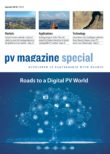pv magazine regularly produces features and special editions in collaboration with our trusted industry partners. On this page, you can download low-resolution PDFs of our Huawei specials, to be read online and on the go, at your convenience.
2022
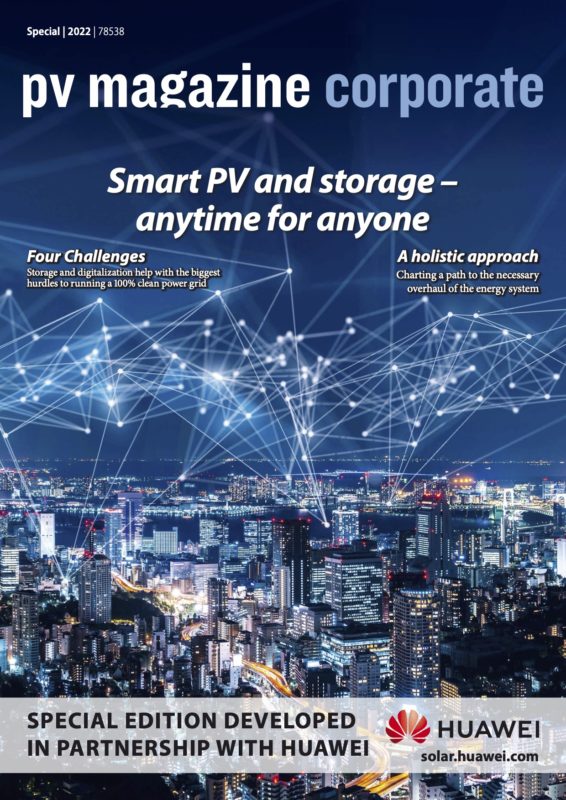 This year Huawei's special edition looks at technical challenges to a power system mostly run by inverter-interfaced power sources. This editions leading topic: Smart PV and Storage – Anytime for Anyone, is achieved by a high degree of digitization, a new business division within the Huawei corporation and strong network of partners. View and download the edition here.
This year Huawei's special edition looks at technical challenges to a power system mostly run by inverter-interfaced power sources. This editions leading topic: Smart PV and Storage – Anytime for Anyone, is achieved by a high degree of digitization, a new business division within the Huawei corporation and strong network of partners. View and download the edition here.
2021
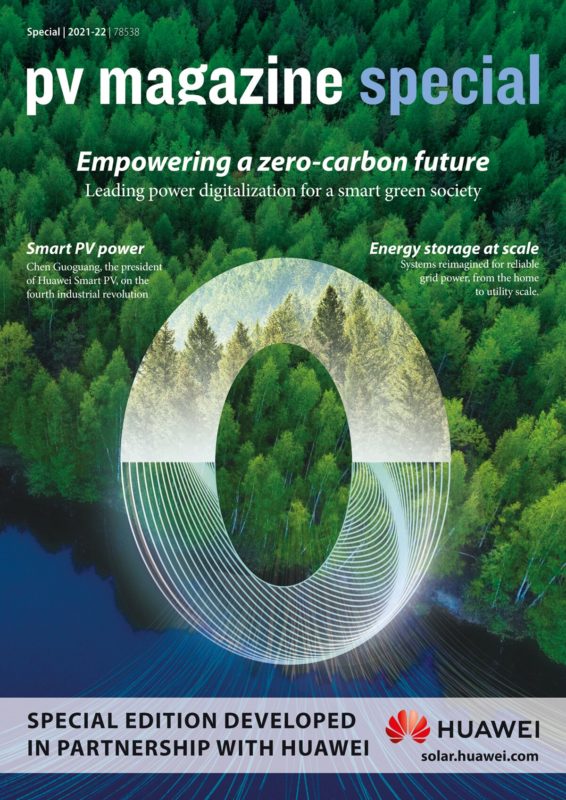 For the sixth time, pv magazine and Huawei partnered to produce a 2021 Special Edition. The focus this time is on powering a zero carbon future and power digitalization for a smart, green society.
For the sixth time, pv magazine and Huawei partnered to produce a 2021 Special Edition. The focus this time is on powering a zero carbon future and power digitalization for a smart, green society.
View and read the entire 2021 publication online.
2020
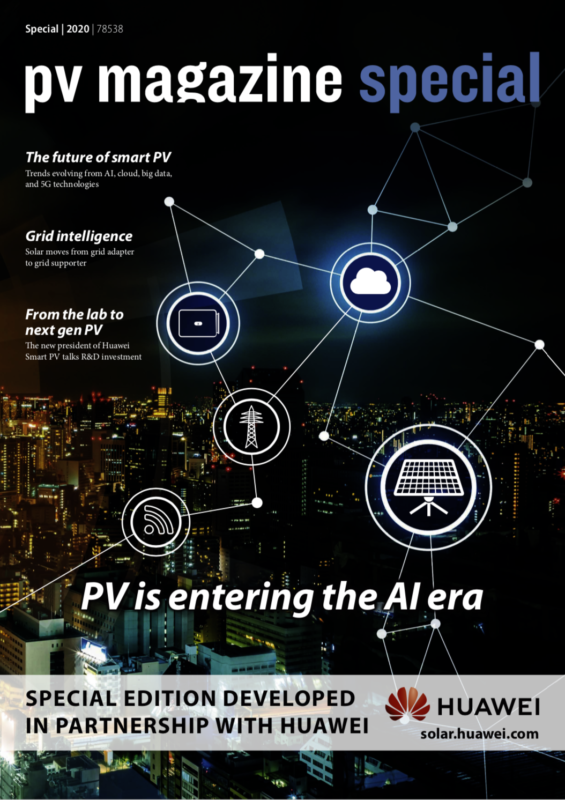 pv magazine has partnered with Huawei for the fifth consecutive year with our 2020 Special Edition. This year’s publication highlights the PV industry’s movement into the Era of Artificial Intelligence, which is quickly advancing through information and communication technologies (ICT).
pv magazine has partnered with Huawei for the fifth consecutive year with our 2020 Special Edition. This year’s publication highlights the PV industry’s movement into the Era of Artificial Intelligence, which is quickly advancing through information and communication technologies (ICT).
View and read below the entire 2020 publication online or download the PDF.
2019
Another year, and another Huawei special edition, ready for Intersolar Europe. View and download the entire 2019 pv magazine Huawei special here.
2018
Once again, we teamed up with Huawei to bring you a 44-page special edition, just in time for Intersolar Europe. View and download the 2018 pv magazine Huawei Special.
2017
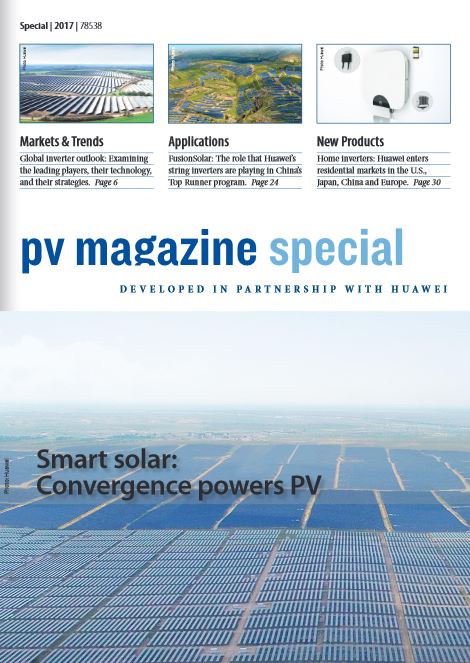
This pv magazine special, developed in partnership with Huawei, made its debut at the Intersolar Europe exhibition on May 31. View and download the entire 40-page special edition.
Articles produced in partnership with Huawei for the pv magazine special publications
The evolution of solar intelligence
Artificial intelligence (AI) is already transforming a range of industries, from the automation of trading decisions in the financial sector to the deployment of smart robots in factories. In one 2017 study, PwC estimated that AI could contribute up to $15.7 trillion to the global economy by 2030. Solar has jumped on the AI bandwagon.
In the PV industry, AI is now being used to help push solar toward grid parity in markets throughout the world. The International Renewable Energy Agency (IRENA) asserts that such technologies are already playing a “transformative” role in pushing the global energy transition forward, even while acknowledging that some people may already view terms such as AI, big data, the Internet of things (IoT), cloud computing, and blockchain as hackneyed buzzwords.
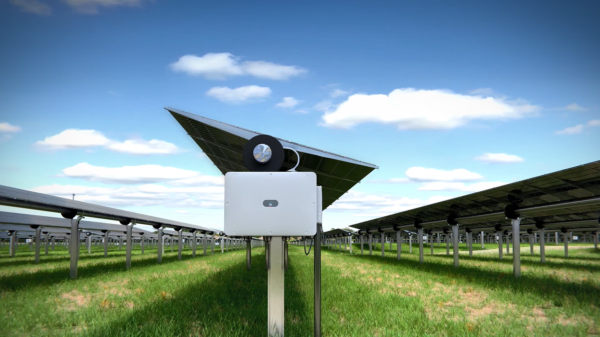 However, these terms are part of the growing digitalization of electricity generation, distribution, and consumption. And in the world’s biggest solar market, China – where the authorities recently outlined a series of policies to expedite the development of subsidy-free solar projects – these technologies are rapidly driving further reductions in PV plant costs.
However, these terms are part of the growing digitalization of electricity generation, distribution, and consumption. And in the world’s biggest solar market, China – where the authorities recently outlined a series of policies to expedite the development of subsidy-free solar projects – these technologies are rapidly driving further reductions in PV plant costs.
Powerful potential
The potential of AI in energy has been known for years, and digitalization of the transmission sector is at an advanced stage, the International Renewable Energy Agency says in its report, Innovation Landscape for a Renewable-Powered Future.
Although sensors have been installed in solar arrays from almost day one, the digitalization of generation and consumption is still at a relatively early stage. The next step, IRENA argues, will be to modernize power plants and further automate control of the grid.
The role of AI in power systems is rapidly becoming a “necessity,” IRENA asserts, as it can help to more effectively integrate variable renewables into the grid by predicting generation and consumption patterns.
“Reductions in uncertainty in power production forecasts and power demand forecasts enable smarter operations,” agrees Elizabeth Traiger, senior researcher at energy consultancy DNV GL. “Unexpected curtailment can be reduced, and planned maintenance can be scheduled at optimal times.”
Investors in new solar projects can use sensor data to provide an accurate picture of the generation possibilities at proposed sites, opening up financing potential. Solar arrays provide enormous amounts of data that are already being used in meteorology applications.
“AI and machine learning algorithms are being proven in forecasting to improve the accuracy of short-term forecasts, up to 48 hours ahead,” explains Traiger. “By combining the wealth of meteorological ground station data, satellite weather data, and local cloud cover imagery, the irradiance, or available solar resource, can be more accurately estimated. The resulting reduction in uncertainty in solar power production helps to ensure a balanced and reliable electrical grid. Variability can be anticipated and alternate dispatch or adjustments to generation can be made more smoothly.”
Scratching the surface
Solar manufacturers are also starting to deploy AI in their factories to streamline production. JinkoSolar, for example, recently revealed plans to use AI at its 400 MW module factory in Florida, starting with electroluminescence inspections. However, the industry is still just scratching the surface of AI’s potential to push solar closer toward grid parity.
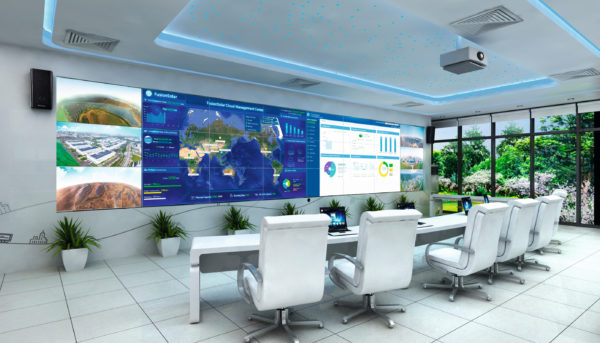
Image: Huawei
“The integration of AI will enhance the ability of solar to integrate in the dynamic energy mix,” says Traiger. “AI enables accurate, informed decisions in all data- heavy areas. For solar, this encompasses the entire value chain: feasibility, development, operations, and decommissioning. Making smart decisions ensures the best outcomes by adding reliability and reducing the variability inherent in renewable resources such as solar.”
That said, the solar industry still has a long way to go in more effectively exploiting data, she adds.
“AI and machine learning is based on data. As we gather more data, from historical sources, past weather and production patterns, different spatial resolutions of new satellites, as well as new data from increased ground sensor installations, the tools will evolve,” Traiger says.
Smarter storage
As the global cost of solar continues to fall, developers increasingly struggle to reduce risks and improve returns on distributed generation PV projects. The ongoing decline in the cost of energy storage provides a ray of hope, but in order to truly leverage the power of storage, project operators need to utilize AI to provide new sources of value. These value streams include lower demand charges and the provision of higher revenue from virtual power plants (VPPs).
California-based storage specialist Stem, for example, announced plans in late 2017 to install AI-backed storage solutions in Japan, a global hotbed for VPP deployment. Other recent AI-backed storage pilots noted by IRENA include French utility RTE’s Ringo Project, which aims to ease grid congestion without the need for new power lines, by using AI to facilitate dispatch.
The future potential of AI-driven solar+storage is huge, with IHS Markit recently predicting that more than 500 MWh of storage capacity will be paired with utility-scale PV projects this year in North America alone, in what the research firm describes as “the first meaningful volumes” to be deployed.
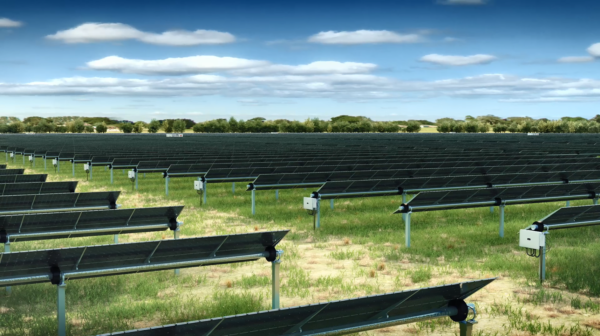
Image: Huawei
Intelligent inverters
IHS Markit expects an uptick in the use of AI in the solar sector this year, and it sees inverters as playing a “critical role” in this shift. It also expects 11 million PV inverters to be connected to the Internet of energy this year and characterizes the digitalization of the grid as a “mega-trend.”
PV system maintenance, in particular, is becoming more predictive thanks to the growing use of monitoring software, which helps system owners and O&M service providers identify problems before disrupting a solar array’s output. Sensors in inverters facilitate predictive maintenance, and many companies have taken notice of AI’s potential. Huawei, for example, has been exploring smart PV solutions for the past five years, as part of its efforts to accelerate grid parity with AI. Its inverters serve as smart sensors, providing the feedstock needed to continuously improve its AI algorithms, which are used to optimize O&M practices.
Huawei’s AI-driven FusionSolar 1500V Smart PV Solution also boasts a number of features aimed at supporting the push toward grid parity. Intelligent trackers and bifacial modules are backed by AI algorithms, while its Smart I-V Curve Diagnosis and AI recognition technologies facilitate automated O&M of PV projects.
Many companies have long used automated drones for inspections to identify defects in advance. But inverters show promise to provide faster, better intelligence.
“Algorithms that can give early warning of faults such as inverter failures, or indicate any deviations from normal operating behavior will be instrumental in maintaining even higher levels of reliability for long-term reliance on consistent solar production,” says Traiger.
Tip of the iceberg
But even with solar O&M, there is still a great deal of untapped potential. Data from sensors can help prospective investors with due diligence, while also contributing to certification of equipment, for example.
“AI can, and will, definitely change and improve solar O&M in many ways and we are only now seeing the tip of the iceberg of the applications that will be commonplace,” says Jaime Sureda, Director of Digital Transformation for Spanish O&M specialist Solarig. “Price reductions coming from the use of AI in the sector will definitely foster the use of solar energy all around the world.”
Solarig has serviced roughly 4.5 GW of solar capacity around the world, and is now in the process of digitally overhauling its operations, with important ramifications for its customized O&M management platform. A key aspect of this shift is the optimization of data collection, integration, and management. It collates data from its monitoring software and uses it to continuously improve its predictive maintenance algorithms. It says such technologies are contributing to significant reductions in global O&M costs, and it says it is using AI to “squeeze” data it collects from a range of sources.
“We are also paying particular attention to the use of cutting-edge technologies in those areas with the highest impact on direct or indirect costs, such as labor- intensive activities,” Sureda explains, noting that the company has long used thermographic camera-equipped drones to spot defects in arrays.
While companies such as Solarig have long used sensors to assess the impact of weather conditions on contractual performance requirements, Sureda argues that the challenge ahead is to further integrate such information with weather forecast- ing models to predict the output of PV plants.
“AI applied to this analysis is crucial and will definitely help to improve plant operations in the near future by increasing the reliability of electricity generation models,” Sureda says.
The growth of distributed-generation PV and technological advancements in AI have fuelled the proliferation of smart devices and demand-management services in recent years, contributing to significant changes in the global power sector, IRENA says. But the organization believes that developers need to launch more pilot projects in the years ahead to fully grasp the potential of digital solutions.
“The disruptive potential is only beginning to be understood,” IRENA concludes. “It is far from being fully exploited.”
Grid parity's hackathon
In October 2018, Huawei released its AI strategy and a full-stack, all-scenario AI portfolio solution. The company’s full-stack capabilities are based on a cloud-pipe-device strategy which connects enterprise intelligence, equipment, and intelligent terminals integrated with AI. Huawei has not only incorporated AI into its internal production, logistics, and processes, but has also joined with partners to promote the development of intelligent solutions across industries.
In the energy sector, Huawei has been working with its industry partners to explore digital practices for smart PV since 2014. Collectively, the companies are promoting artificial intelligence and digital technologies such as cloud computing, big data, Internet of things (IoT), and edge computing to work in synergy for further reduction in PV plant costs across the industry.
The PV industry is embracing grid parity globally. Regions particularly rich in solar irradiation resource such as India, Spain, Latin America, and the Middle East, have ushered in the new era. By 2020, most parts of the world will be able to achieve full grid parity. Advancing the global energy transition is crucial to addressing climate change, and bringing LCOE down for grid parity will be the key element and driving force to a clean energy future across all markets. And Huawei is turning to AI to accelerate grid parity.

Image: Huawei
Taking the lead
In the intelligent era, innovation has become the core competency among leading enterprises. According to IHS Markit, Huawei has been ranked number one in global PV inverter shipments for four consecutive years. The company attributes its successes to customer-oriented innovations that simplify complex problems through fully digital technologies in its electronics, chips, computing, and artificial intelligence.
“Each inverter of Huawei is a smart sensor. The massive amount of data collected by increasing numbers of sensors optimizes more machine learning algorithms and effectively and continuously trains AI models, thereby enhancing the AI capability exponentially,” says Jeff Yan, Senior Product Manager at Huawei. “This helps Huawei optimize and manage power generation and O&M in a refined manner, which radically changes the traditional management mode and brings a revolutionary impact to the new energy industry.”
Huawei’s FusionSolar 1500V Smart PV Solution has five particular characteristics that support the drive toward global grid parity.
Bifacial PV modules+smart trackers+multiple MPPTs
Huawei abandons traditional astronomical algorithms and adopts intelligent trackers and bifacial PV modules with AI algorithms to maximize energy yields by integrating tracker control, power supply, and communication. According to Huawei, a test conducted on a large PV plant in northwestern China demonstrated an energy yield more than 20% higher when using a bifacial modules+smart trackers+multiple MPPT solution, in comparison with monofacial PV modules+fixed trackers+central inverters solution. AI auto-learning enables trackers and bifacial modules to be optimized using the tracking algorithm, which can provide an additional 0.5 to more than 1% in energy gains, according to Huawei.
Informatization of PV devices for building smarter plants
By combining digital components with AI algorithm controls, the solution enables the collection of high-precision digital information to improve energy yields. PV strings can be monitored with the precision of 0.5%. Big data and AI algorithms are oriented to component-level monitoring and refine management to locate old and faulty devices.
AI recognition+Intelligent O&M
Huawei has further upgraded its Smart I-V Curve Diagnosis. The Smart I-V Curve Diagnosis and AI recognition enable the smart diagnosis for multiple components in various scenarios. Currently, the technology has been applied to more than 3 GW of PV plants worldwide. The application of AI enables automated O&M of PV plants. According to Huawei, one-click scanning of its Smart I-V Curve Diagnosis 3.0 ensures the scanning of all strings in a 100 MW PV plant in just 15 minutes.
Another powerful technology used for O&M is its discreteness analysis. In the past, faults were cleared manually, which was time-consuming. Some faults might be ignored completely. “With discreteness analysis, a PV plant in the Shanxi province of China accurately had 283 faults located in half a day. After more than 20 days, the PV plant cleared almost all faults with the performance ratio (PR) improved by 2.52%,” says Yan, “Traditional PV plants, however, take about two months or more to clear faults before feeding power to the mains power grid.”
Grid-tied stability of PV plants based on AI algorithm control Huawei has established a precise mathematical model for different types of grid- tied scenarios and PV plant designs, and imported related data by testing the power grid waveforms of steel mills and electrified railways into the model. The mass of data is used to train the optimal grid-tied control algorithm.
By doing this, Huawei ensures stable grid-tied power generation of inverters even if they have poor power grid waveforms. “The power quality meets or even outperforms standard requirements,” adds Yan.
Health check reports
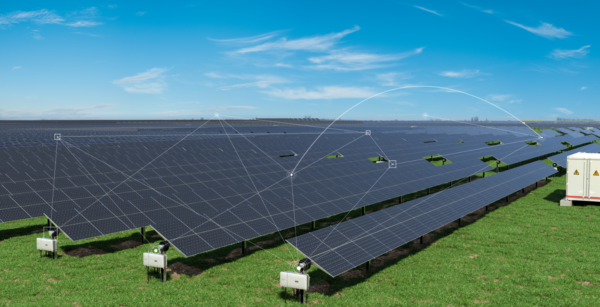
Image: Huawei
Huawei offers PV plant health check reports with customized indicators for controlling the operating status of PV plants in a one-click manner. By analyzing the environment, energy yield benchmarking, loss caused by power rationing, and power loss, Huawei uses big data and intelligent analysis methods to perform a one-click health check and generate comprehensive evaluation reports for PV plants with O&M suggestions.
Operations and maintenance managers can quickly find the causes of low energy yields and laggard PV strings, thereby liberating personnel from time-consuming inspection and data analysis, thus reducing labor costs. “The magic of this feature lies in the perfect combination of expertise and AI,” says Yan.
How do these five characteristics benefit customers? “Based on comprehensive analysis and calculation, the AI-aided Huawei 1500V FusionSolar Smart PV Solution can effectively reduce the initial investment by more than $0.05/W and reduce the levelized cost of energy (LCOE) by more than 7% in China,” says Yan. “This is key for speeding up grid parity.”
In 2019, Huawei will use the AI-aided 1500V FusionSolar Smart PV Solution to continuously reduce LCOE and accelerate the grid parity process.
Next generation inverters optimize bifacial boost
Inverter makers are under pressure to upgrade performance to accurately measure and manage the boost from bifacial solar panels. Inverter improvements including greater granularity of maximum power point tracking (MPPT), the marriage of artificial intelligence with more capable algorithms, and string overload safety are ushering in the next generation of inverters redesigned for bifacial systems, according to the development team at Huawei Technologies’ Smart PV Business.
The complexity of matching inverters to bifacial panels arises from the dynamic and uneven light capture levels on the rear side of the panel over time. Different sources of reflected light on reflective surfaces with different albedos, or reflected light values, permutate to make bifacial light capture management no less than a symphonic performance for inverters. Huawei Technologies’ FusionSolar Smart PV Solution has refined inverter technology to address these issues, while providing substantial increases in bifacial system yields in the process.

The moving target of the energy yield gain from the rear of the bifacial module varies depending on the scenario, but the energy yield can increase anywhere from 5% to 39%, according to Huawei research. Beyond that base gain, the bifacial module can further increase the energy yield by 2% to 6% based on its performance in response to low light and low power loss under the working temperature, the researchers point out. Thus, the combined “ energy yield gains of a bifacial module can range from 7% to 45% when compared to a conventional monofacial poly-Si module, a goal the industry is eagerly pursuing.
Inverter load flexibility critical
Designing inverters for bifacial modules that are capable of managing a large and varying yield gain is a first basic task. If inverters are not upsized to efficiently match and adapt to the dynamically enhanced DC output from bifacial pan- els, then they will suffer from clipping and yield loss. Balancing the need for capability versus size is a delicate design problem.
Industry research on bifacial systems currently focuses on ray-tracing and view-factor models, based on 3D modeling, to narrow down the best targets for design optimization. While more details can be displayed by algorithms, computing is complex and time-consuming, which does not mesh well with improved inverter performance.
Huawei has simplified and optimized the two models and launched an industry- leading intelligent design tool for bifacial module systems based on the 2D physical model, according to Shawn Gu, the Chief Scientist for Huawei's Smart PV Business. Huawei Smart Design is the online design platform for the company’s Smart PV solution.
Smart Design is used to assist in plant system design, including component selection and energy yield assessment. The tool can determine the balance point between calculation speed and design details, quickly and accurately calculating the optimal configuration of a bifacial module system.
Huawei’s 2D modeling method increases the overall energy yield from a bifacial PV system by more than 3% com- pared with solutions provided by other standard design methods, says Gu. This further compounds the bifacial boost.
Resolving overcurrent issues
Secure and reliable protection design is another key attribute of the next-gen bifacial inverter. “Every two strings of the Huawei FusionSolar Smart PV Solution string inverter form one MPPT circuit and have a fuseless security protection solution. The design ensures that no risk will occur at overcurrent condition,” says Gu. At the same time, security risks, frequent fuse replacement, and energy yield loss caused by fuse faults are avoided.
Inverter anticipation of a fault is another key capability for bifacial system design. Since frameless and glass-glass module designs suffer from a higher risk of cracking than modules with frames, the inspection of module fault is a top- most priority for O&M. “The complexity of the I-V curve of the bifacial module makes the intelligent diagnosis of string faults easy to misjudge,” notes Gu. Huawei’s latest Smart I-V Curve Diagnosis V3.0 uses a new, intelligent string diagnosis algorithm with a built-in database. This combination enables optimization of the input and output feature curves of various manufacturers’ PV modules, automatically filtering out the data “noise” that causes misjudgment.
MPPT granularity
Another necessary tool for bifacial inverters is more granular and dedicated MPPT units, industry experts broadly agree. “To prevent current mismatch within a string, there is a crucial need for dedicated strings supported by higher MPP granularity. Ideally this should take place at the individual string level,” says Shashwat Kumaria, Director of Engineering at Sunpreme.
The multiple sources of reflected light on the rear side of a bifacial panel, in wide variance during the day, necessitate far more detailed sensing by the inverter. With the mismatch of the bifacial module high, its I-V curve is more complex than that of a monofacial module, and its power-voltage curve will generate multiple peak values over time. This poses higher requirements on the detection precision and MPPT of inverters.
Thus, using more MPPT units per string was a beginning requirement for Huawei’s redesign of the optimal inverter for bifacial systems. “Our string inverter has multiple MPPT units, which can precisely track the maximum power point of every one or two PV strings, releasing the maximum output power of each PV module. This greatly reduces PV string mismatch caused by distance and shade between modules, along with other issues,” Gu says.
The degree of granularity improvement required will depend on the bifaciality factor of a given panel. “Since the overall output power of the [combined sides of the] PV module is different, the current discrete rate of the module is more than five percent. So, the MPPT granularity of inverters needs to be finer,” explains Gu. “Based on the Monte Carlo statistical method, the mismatch loss of a bifacial panel yield caused by inverters with one MPPT circuit per two strings is 1.1% lower than the loss caused by common inverters in a bifacial module system,” he adds. “In practice, the environment is not as ideal as expected in the simulation and therefore an even lower mismatch loss can be achieved by the multi-MPPT feature with two strings in one MPPT.”
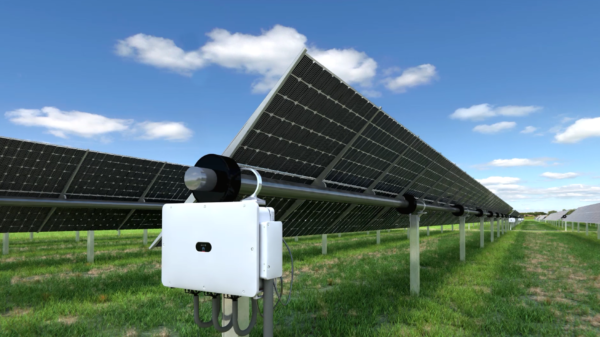
Image: Huawei
AI algorithms crunch big data
Another key tool for advanced inverters serving bifacial systems is the use of AI and algorithms for analyzing the bifacial data that more granular inverters are read- ing. “Bifacial strings inherently result in more complex I-V curves so there is a definite need for more robust MPP tracking algorithms tailored to accurate MPP identification under steady-state and dynamic [partially cloudy] irradiance conditions,” Kumaria points out.
Huawei is prominent among the inverter suppliers pushing the algorithm envelope for bifacial applications, Gu asserts. “This year, our FusionSolar Smart PV Solution has further applied AI technology to PV plants. We have updated the traditional astronomical algorithm to achieve the integration of tracker control, power supply, and communication, thus maximizing energy yields.”
With bifacial projects, maintenance is a more complicated issue than for mono- facial systems, given the relative value of the boost components. “Big data analysis plus AI algorithms are oriented toward more refined component-level monitoring and management,” says Gu. “This can proactively identify a low-performance unit, in a revolutionary switch from passive maintenance to active, predictive maintenance.”
Avoiding infinite calculations is a major contribution of AI, which eliminates much of the cumbersome rote method of data analysis.
“From the aspect of hardware, faster scanning of voltage and power must be supported, but frequent scanning of MPP will cause power loss. After introducing AI that includes high-speed memory and a tailored algorithm, the system gains the ‘experience’ to deal with all cases without frequently scanning,” Gu explains.
Such a melding of AI and algorithms can provide a system boost all of its own, a situation where the whole has more value than the sum of the parts alone.
“An intelligent design tool for bifacial systems integrates full-scenario, adaptive, and self-learning intelligent control algorithms to accurately enable an optimal design solution,” Gu explains. “This increases the energy yield by more than three percent compared with solutions provided by other standard design methods.”
Connecting intelligent power
Information and communications technology giant Huawei is on a mission to build a fully connected world. Operating in more than 170 countries and regions to serve more than three billion people globally, the company is well on its way. In this exclusive interview, pv magazine meets with Tony Xu, President of the Smart PV Business unit at Huawei, to discuss the technological breakthroughs, trends, and policies that have the company driving solar PV into the era of digitalization.
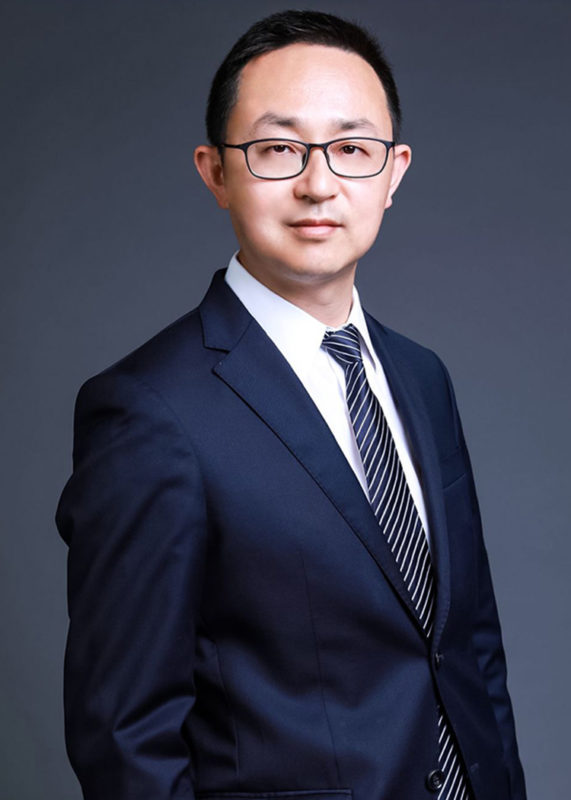
Image: Huawei
One year ago, you told pv magazine that your vision for 2018 would be to bring digitalization to every person, family, and organization to build a fully connected, intelligent world. What progress has Huawei made to this end over the last year?
The vision of Huawei is to bring digital to every person, home, and organization for a fully connected, intelligent world. We set up and repeat this vision during past years and now by including our inverter sector, the entire Huawei company is heading towards this future. The vision includes three levels or stages. All things sensed, all things connected, and all things intelligent. First, we try to modify and make things sensible, which means data and information can be sensed and collected from the environment. Then we use connection means, including wired or wireless, especially 5G technology, to connect all of them into the network, and onto the cloud. In October 2018, Huawei announced the Full Stack All Scenario AI Solution, and we now provide the AI functions and solutions from bottom chip level to industrial level.
Our target with AI is to set up a platform on which our partners can provide specific and customized AI applications for end users. We just provide the basic infrastructure service for AI developers, just like the power grid: You use electricity, but you don’t need to know where and how the electricity is generated.
We follow the general Huawei company strategy for our Smart PV Business Unit. Our latest FusionSolar Smart PV Solution is pre-equipped with AI, cloud computing, and big data technologies. These features can help our customers to achieve higher yields with optimal LCOE, locate problems quicker, and achieve better performance. With Huawei’s FusionSolar platform, we already help customers to operate and maintain more than 30 GW of solar PV projects. And we will continue in our devotion to this sector.
Are there regulatory burdens to overcome in certain markets?
We know people are curious about this question of Huawei, especially under the current China-U.S. trade war, in which Huawei was named by the U.S. several times. Honestly speaking, we have not experienced such kind of obstacles in Europe when marketing our inverter products. We have very good relationships and cooperation with our European customers, and we will continue to serve them and follow our customer centric principle.
The inverter market segment is very dynamic. What are the big trends of the inverter landscape this year?
Because of the spread and popularity of bifacial modules, which we believe is an obvious market trend, it will be important in the future to better connect inverters with high-efficiency bifacial modules, tracker support structure, and multi-MPPT. I think this will influence the investment and the future of inverters greatly. If this is correct, the future prospect of large centralized inverters is dim.
We have worked and cooperated with several key partners including tracker support structure providers, module suppliers, and EPCs to observe the actual performance. Of course, we have identified some problems that need to be resolved. We believe there is still a process before this becomes mature, and we are working with our partners to push it.
For four years, Huawei has continuously ranked number one in inverter shipments. What is key to Huawei’s success?
First, it is because of the platform of Huawei Company. The platform attracted talented people, and talented people make the business successful. Second, it is because of the brand of Huawei. For a product that needs 25 years of service life, the manufacturer should survive that long to serve its customers. And the core factor is that we provide good products and solutions.
At Huawei, our smart employees have devoted themselves to this inverter product, bringing their experience and quality control expertise from ICT products with higher requirements. We have found that our customers, especially from Japan and Europe, are most concerned with stability, which is exactly what we are good at – based on the system of Huawei.
What will be the main themes for Huawei's marketing of inverters in 2019? And what does Huawei predict for the market in the future?
In 2019, our market focus is still on products and solutions for lowering LCOE. We face challenges from our competitors and the market. We are concerned with market trends, but no matter how markets change, we will focus on providing the lowest LCOE in the inverter sector for our customers. We believe this is the key factor that makes Huawei’s inverter irreplaceable.
We shipped over 90 GW of FusionSolar globally through December 2018. Our over- seas shipments recorded at 48% of total in 2018, with 52% domestic. With the rapid growth of overseas markets, we estimate the growth could be 100% over 2018 this year. In Q1, we had a 140% increase in our overseas sales. In 2019, overseas shipments may increase to 70% of our total business.
In the future, we will try to control the number of customers which we directly do business with to less than 100 and establish a distributor system to handle all other customers. This means a shift from previous direct sales to a distributor system, and we’ll cut our costs in sales and marketing.
People in the industry are watching closely as China’s next policy move is expected. How do you think your domestic market will play out in 2019?
Yes, lots of people including myself are watching and waiting for the policy. From the news released so far, personally I believe it will be a positive policy for China’s PV industry.
First, due to the international rules which you will face outside of China. Second, the new policy will benefit those manufacturers that produce at high quality and eliminate low quality products. A really good policy will drive the industry to grow even stronger. We are working to understand the policy to try and figure out how to match the policy to our product, human resources, marketing, and even structure.
Do you think Huawei has met or is going to meet some kind of bottleneck in growth?
Presently, solar PV accounts for around two percent of total power generation globally. I think in future solar with storage will very probably be the most promising renewable energy. If I am right, the total installation capacity will be tremendous compared to its current size. The market is just at its beginning stage. Actually, all the major energy giants including State Power Investment Corporation (SPIC), Huaneng Power, Électricité de France (EDF), and others are just getting started in their transformation from traditional power to renewable energy.
Because of declining costs, solar PV energy is now the cheapest power source in many places. This will terminate investment in traditional energy. The future market of solar PV will be ten or even a hundred times its current size.
Taiwan’s rapidly developing PV market
Taiwan became a gigawatt solar market last year and capacity is expected to grow even further in 2019. Chen JuiHsin is the Vice President of Chailease Holding, the largest EPC and PV solar plant owner in Taiwan.
Due to significant declines in pricing for solar PV products including cells, modules, and other parts in 2018, grid parity is becoming more and more widespread. What is Chailease’s perspective on the future of Taiwan and Southeast Asian PV markets?
Currently, Taiwan still has a good feed-in tariff (FIT). Even though it’s not as significant as that of mainland China, the profit margins are considerable given declining costs. We take several factors into consideration when assessing investment in PV projects and markets. Taiwan has limited political and financial risks, and solar resources are also pretty good. There are climatic disasters, especially typhoons in the summer, which pose threats for PV projects. But generally speaking, we see a strong prospective PV market for Taiwan [through] 2025.
For Southeast Asia, there are significant differences between each country. Thailand is the best market for our company due to energy costs, sufficient solar resource, and the key: a stable political environment. We have been in the market for a long time, and have strong relationships established with local partners. Malaysia is also a strong market, but energy costs are quite low compared to Thailand due to its richness in oil resources, and it also has a lot of natural disasters.
Vietnam and Cambodia are both potential future markets, but in the current situation, insufficient infrastructure negatively impacts PV investment. We believe that the political and financial risk is pretty high in both the Philippines and Indonesia, so we are very cautious in entering into these markets to do local business. Chailease Energy’s market strategy differs in the various ASEAN countries.
With the rapid growth of Taiwan’s PV industry, can you tell us about the size and scope of the projects that Chailease is developing in the market?
I have to say that as an EPC (engineering, procurement, and construction) provider, Chailease Energy is quite different from other players in the market. Our PV business initiated from our small and [medium-sized] enterprises (SMEs) leasing business which shaped Chailease Group. We don’t have iconic projects to show as other EPCs typically do. Each project we have done is quite small, though not at a residential scale, and dispersed geographically. Dispersing projects helps reduce risk, particularly with climatic factors such as typhoons in Taiwan.
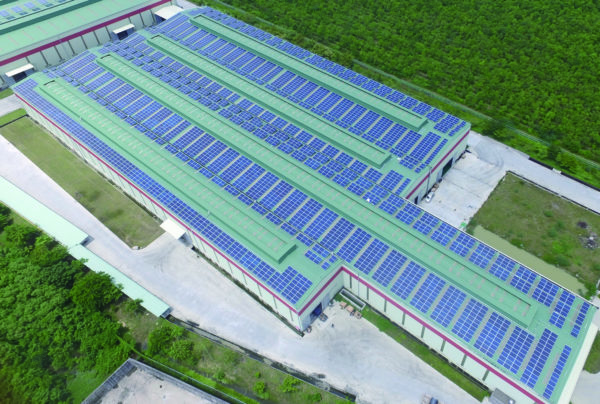
What is your current installed capacity? And in the future, what is the primary target sector for Chailease solar projects?
At the end of 2018, we had a total of 370 MW of PV capacity installed across more than 1,200 projects. This year, we anticipate completing another 400 to 500 projects for an additional 150 to 200 MW of capacity, which will represent a significant increase for us. In the future, we will consider moving toward working on more utility-scale PV projects. We have a lot of experience in developing PV projects, and we believe we can go bigger and better.
We know Chailease’s FinMart project has been focused on providing investors with a long-term stable return on investment. This kind of project requires a higher degree of quality for all system components. Can you describe Chailease’s quality requirements for components and the inverter?
Since we provide investors a guaranteed return of 20 years, we have very strict requirements about the components used for our PV projects. The most important factor for us is to have a high degree of confidence that the manufacturer will survive for the next 20 years, so that it can continuously serve our projects and investors. Beyond that, we have two other quality requirements that we are looking at.
First, considering the harsh environmental conditions of Taiwan, such as high temperatures, rainstorms and lightning, and typhoons, we want to keep maintenance costs low and need the parts to have the lowest failure rate possible. Second, the efficiency rate should be high and stable.
Chailease has built a number of solar projects and accumulated extensive experience. How does your company go about choosing inverters?
Usually, we have two or three vendors for each component. For example, we team up with inverter manufacturers like Huawei, Delta, and Schneider. We chose Huawei inverters initially for their fanless design. We had many poultry farm projects, and if the inverter had a fan cooling system, this would often get jammed with chicken and duck feathers and particles. Maintenance would be difficult and costly with fans, and there was high risk for the inverter to accumulate heat and burn out. We tested Huawei’s inverters for quite some time and found that their product is extremely suitable for the conditions of PV projects in Taiwan.
Over the last two years working in cooperation with Huawei, we have found that they’re a strong, quality vendor. They produce high quality inverters. Beyond that, they have a great service attitude and are quick to respond. We feel their respect, and that they really understand customer needs.
Has Vietnam’s moment in the sun finally arrived?
New solar PV installations soared for Vietnam in 2018 — at least in relative terms, they did. The nation’s cumulative installed PV capacity stood at just 106 MW by the end of 2018, according to statistics from the International Renewable Energy Agency (IRENA). That number looks paltry when stacked against regional rivals such as Thailand and the Philippines, but represents a huge jump from just 8 MW a year earlier — the approximate level at which the country’s total PV installations had languished for much of the past decade.
A recent series of policy announcements — and looming revisions to Vietnam’s feed-in tariff (FIT) program — have left many investors hopeful that the Southeast Asian country is finally poised to unlock its PV potential in both the utility-scale and commercial rooftop segments.
“Under the current FIT, there is tremendous developer activity going on right now. Almost purely in the utility-scale segment,” says Josefin Berg, Research and Analysis Manager for IHS Markit.
The Vietnamese government is expected to officially publicize its new solar FIT rates before the end of the first half of this year, as current rates are set to expire on June 30, 2019. Proposed FIT rates for ground-mounted projects range from VND 1,525 ($0.065) to VND 2,102
($0.09), depending on the region. Suggested rates for floating PV systems — a key government policy priority in land-scarce Vietnam — have ranged from VND 1,566 to VND 2,159. Solar+storage installations, meanwhile, could receive rates of VND 1,994 in the country’s southern provinces or VND 1,196 in the central highlands.
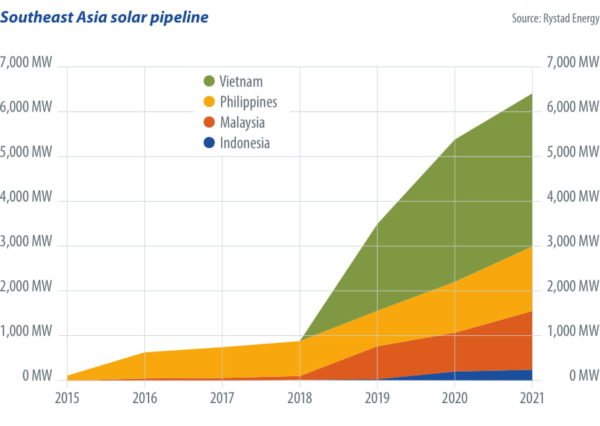 Berg expects solar developers to install as much as 2 GW of utility-scale PV capacity in Vietnam in 2019, primarily in the first half of the year.
Berg expects solar developers to install as much as 2 GW of utility-scale PV capacity in Vietnam in 2019, primarily in the first half of the year.
“The boom doesn’t stop here. As there have been extensions to the FIT in some zones, we project more than 2 GW of utility-scale PV also in 2020,” she adds.“Then the new proposed FIT would be likely to trigger another 2 GW in 2021, but with development shifting to the north.”
Looking ahead, it remains to be seen how long the revised FIT regime will remain in place, says Berg, noting how other solar FIT markets throughout the world have come to abrupt ends in the past. “The big question is how [state-owned power company] EVN will react to this amount of capacity and the related costs,” she explains.
Measured approach
Oliver Massmann, a Vietnam-based lawyer for Duane Morris LLP, says the proposed revisions to the FIT rates suggest that the Vietnamese government is taking a measured approach to solar development.
“Vietnam does not want to develop solar power projects at any cost,” says Massman, explaining that the government has put strict caps on project capacities.
Massmann’s 2019 installation forecast is considerably more conservative than that of IHS Markit, at just 854 MW. Although 2.24 GW of PV capacity was under construction by June 2018, he believes that many of the developers of those projects will likely miss their commercial operation deadlines to claim the FIT rates currently offered.
The newly proposed FIT rates, he argues, appear designed to strike a balance in order to facilitate significant PV build-out, but at prices that state-owned utility Vietnam Electricity (EVN) will be able to stomach. However, there are other potential obstacles to future solar development looming on the horizon.
“In general, the network is underdeveloped,” says Massmann, arguing that the national grid may not be able to handle the modest 2020 target of 850 MW that the government presented in its seventh Power Development Plan — to say nothing of its long-term targets of 4 GW by 2025 and 12 GW by 2030. It also remains to be seen what will happen to the 8.1 GW of solar capacity that has already been approved for development through the end of the current decade, accord- ing to the Ministry of Industry and Trade (MOIT).
“Coal thermal power projects have covered 70% of the total installed capacity, and that limits the available infrastructure, location, and capacity for development of further solar power projects,” Massmann explains. “For example, it is very challenging to find locations near the grid for the development of solar power projects.”
Grid limitations
The limitations of the Vietnamese national grid also make it “very challenging” for solar developers to hit their commercial operation deadlines, Massmann adds. Another issue for utility-scale solar is the Vietnamese government’s draft PPA template. While authorities are now working to revise the template to make it more acceptable to domestic and foreign financial institutions, Massmann says that the draft PPA is not particularly bankable for a number of reasons. For one, the template does not clearly delineate risks for the government and the private sector. It also lacks foreign exchange guarantees, and it remains unclear whether the PPA template is a “take or pay” agreement, according to Massmann. Additionally, PPA negotiations still take an inordinate amount of time and the process is still not sufficiently transparent for foreign investors.
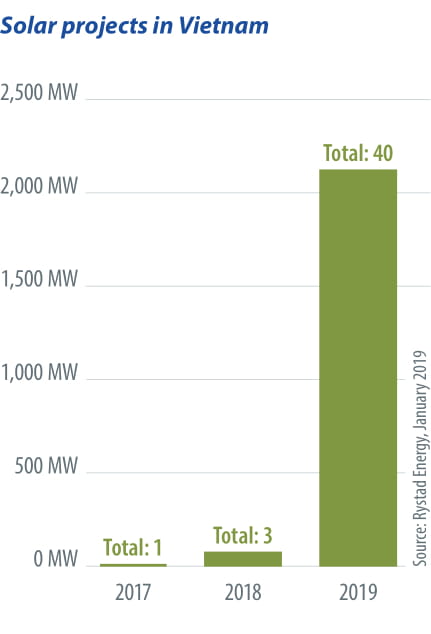
Despite these lingering concerns, the Vietnamese solar market nonetheless offers enormous potential. “There are still many broad opportunities for foreign investors, developers, consultants, and equipment suppliers,” says Massmann, noting that cumulative PV installations remain negligible, with the Vietnamese market still in its infancy.
One encouraging development is that the government plans to introduce a direct PPA for large-scale renewable projects at some point this year. This would allow renewable power generators to sell their electricity directly to corporate consumers. “We believe that foreign expertise in direct power purchase agreement projects is most needed at this point since the pilot direct PPA will be implemented soon,” Massmann says.
Promising C&I outlook
In Vietnam’s fledgling commercial and industrial (C&I) rooftop solar sector, where Massmann expects 19 MW of new capacity to be built this year, the outlook for PPAs is considerably more promising.
In March, the MOIT replaced the old PPA model for rooftop PV and extended the FITs to all C&I projects, effective April 25, 2019. The new version of the PPA features a number of notable improvements, including the clarity that the FIT will be applicable for 20 years from a project’s commercial operation date. The new model PPA also includes a detailed but simple formula to calculate power generation and the price that is to be paid to generators, and separate payment and invoice procedures for companies and households.
“The new model PPA has been simplified for the sale of solar power from the rooftop solar generators to EVN/power purchasers,” Massmann explains, noting that it drops the previous net metering structure which mixed the sale and purchase of power between parties. “[This] is expected to address all outstanding issues of rooftop solar power projects.”
German solar specialist Conergy is similarly upbeat about the potential of Vietnam’s C&I solar space. CEO Alexander Lenz says the country could install more than 1 GW of C&I rooftop PV capacity over the next four to five years. He says that Conergy is therefore “very optimistic” about the country’s potential.
Lingering issues
However, Lenz acknowledges that a number of pressing issues still need to be definitively resolved, such as the 1 MW cap that the government has placed on rooftop PV projects, which reduces the potential benefits that can be achieved through economies of scale. A number of other related laws and regulations also need to be clarified, he argues.
“[A recent solar policy document] defines four business models for solar rooftop investments, but the exact procedures on how to implement these models are not clear. We are assuming that more detailed procedures will follow,” Lenz explains. “The policies in general are supportive of rooftop solar development. [But] the laws and regulations need to be improved to provide more details and clear guidance, not only for the developers/investors, but also for the local government authorities who are responsible for executing the policies.”
Long-standing grid constraints are another issue that solar developers also need to consider when selecting potential project sites, in order to limit dispatch-related risks, according to Lenz. Despite such lingering concerns, the outlook for rooftop PV is extremely positive in Vietnam. With average annual GDP growth rates of about 5-8% over the past 10 years, the country’s electricity demand is expected to outpace the growth of power generating capacity through the middle of the next decade.
A tale of dust and heat
Keeping it cool even in the toughest conditions is a point of concern for many plant owners and EPCs. The trick is striking a balance between ensuring safe and efficient plant operations while keeping the associated costs to a minimum. Reducing the number of moving parts is one way to keep the O&M bill low.
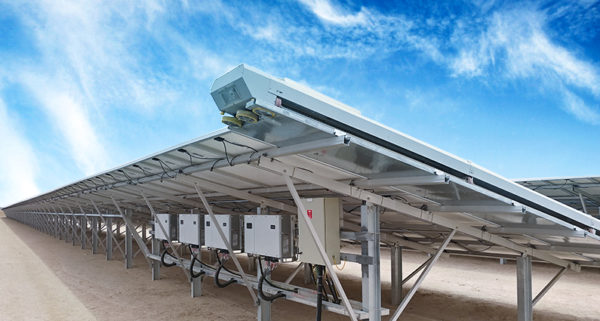
Image: Huawei
The insulated-gate bipolar transistor (IGBT) is an inverter’s ‘heart,’ and a component which produces a considerable amount of heat while switching. However, IGBTs, printed circuit boards, and other electrical equipment start operating at lower efficiency levels when they reach a certain temperature. An increase of just 1-2 degrees above the maximum operating temperature – usually 90-110°C – can cut equipment lifetime in half.
Inverters lower their power output through a process called derating to avoid damaging themselves by overheating. Derating, however, has significant effects on a plant’s levelized cost of electricity (LCOE). The more efficient an inverter’s cooling mechanism, the later derating occurs. A quick look at inverter data sheets shows that most inverters can maintain operations at a maximum ambient temperature of around 60°C, but start derating at slightly above 40°C. Not all suppliers provide data on different outputs under different ambient temperature scenarios, but those who do, admit power losses of between 5% and 10% at an ambient temperature of 50-55°C, when com- pared to 30°C.
The switch from two to three-level architecture has allowed for more efficient high frequency switching without having to use higher voltage or IGBTs that could resist higher heat levels. In the past, many inverters had less than 96% efficiency, and most losses dissipated into heat inside the inverter cabin. Less heat is dissipated today, with efficiency rates beyond 98.7%. In making this step, manufacturers offset the effect of more efficient switching by increasing the power density of the inverters – making cooling an issue yet again.
If a project is located in the scorching heat of a desert, the point at which derating sets in is routinely surpassed. Plant owners then have to accept repeated low falls in production output, with adverse impacts to their LCOE. Installing a fan to more efficiently draw the heat from the inverter cabinet may seem an attractive solution, but dusty desert conditions and the ingress of small particles interfere with the functionality of the delicate electronics.
Huawei says it has found solutions to both of these desert challenges: using natural convection flows without fans to sufficiently dissipate heat. The system would work even with high-power inverters, such as its SUN2000-100KTL-H1 100 kW product. Via natural convection flows of hot air, heat dissipates through heat pipes onto a heat sink on the outside of the inverter. Huawei places heat generating components and sensitive parts in different compartments in combination with various thermal insulation strategies so that the build-up of hot spots in sensitive areas can be avoided. The smart PV technology giant says that because there are no air inlets, the solution is better for dust protection.
The innovative solution shows promise to utility-scale investors, particularly those with their eyes on the Middle East region. A system that works well under the scorching sun, without the cooling breeze of a fan, could have positive impacts on both market expansion and LCOE.
Gaining the most with multi-MPPT inverters
The role of smart technologies in improving solar project costs and yields in India
Sunil Jain is the CEO and Executive Director of Hero Future Energies (HFE), an independent power producer that has an installed capacity of 1.2 GW and is striving to cross 3.5 GW by 2022.
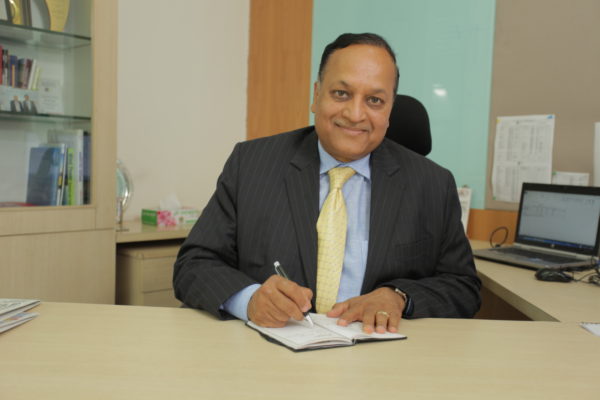
Image: Hero Future Energies
As India’s leading independent power producer with an established global presence, what are your continued plans for growing renewable energy over the next three years?
Hero is presently operating approximately 1,500 MW of wind and solar assets, and has around 1,000 MW under construction, with another 1,000 MW under development. We plan to reach a capacity of 5 GW of solar in the next three to four years. Hero will also go for a lot of innovative projects, like hybrid or tribrid with wind and storage in the coming years.
How would you describe the evolution of India’s energy sector thus far?
The Indian energy sector continues to grow at 6-7% annually. It is evolving to include a large mix of renewable energy and also adopting new technologies to get 30% renewables onto the grid by 2022. I believe then that our energy sector will gradually move to low carbon as renewables will become mainstream in the energy mix.
What role are cutting-edge digital technologies, such as machine-to-machine learn- ing and Internet of Things (IoT), playing in this evolution?
Huge! There are three stages of solar and wind power plants: design, execution, and operation. At the design stage, the use of drones, in conjunction with differential GPS, for land-based topography with artificial intelligence is immensely helpful in plant lay- out design, drainage design, earth-work assessment, etc. This is creating much more accuracy and speed.
At the execution stage, piling and ramming using GPS-based machines ensure automated location of pile coordinates. Even drone-based plant monitoring and process data generation through AI and machine learning is possible. At the operation stage, state- of-the-art robotic cleaning systems, mounted with wind sensors, pyranometers, and IoT-based data analytics, can govern the smart cleaning of modules to ensure higher [power] generation.
The use of drones laded with thermal camera and GPS enables perfect monitoring of module behavior, and defects are diagnosed through machine learning and AI-based data analytics. With string-level monitoring features, it is now possible to communicate string data through IoT, leading to error-free data for accurate assessment. With multi- MPPT (maximum power point tracking) string inverters using high-end algorithms, it is possible to assess the behavior of each string, including the I-V curve. This can effectively prevent technical issues, improve O&M efficiency, and reduce O&M costs.
Power electronics can be the cause of failures in solar installations. In India, what are the specific requirements that inverters must meet?
Reliability and performance of power electronics-based devices are critically dependent on the ambient temperature, humidity, and presence of vermin, etc. Tropical countries like India are characterized by high temperatures and levels of humidity, and also have the presence of lizards, rodents, and snakes. The inverters must be designed to have protection from such extremes.
What made you choose Huawei as your preferred inverter partner?
Huawei is one of the largest R&D-oriented organizations, with their products using state-of-the-art technology. The company manufactures high-efficiency string inverters, with greater than 99% efficiency and the multi-MPPT feature, unlike central inverters which carry efficiencies of approximately 98.3% and single MPPT. Multi-MPPT is extremely advantageous for installing PV systems on any land profile, including high sand dunes or mountainous zones. Due to Huawei’s high-end technology, it is possible to load such inverters beyond 200% DC. There is an observable gain of more than 3% vis-à-vis central inverters. With the inverters being distributed in nature, their mean time to repair is also very low.
Due to falling tariffs, does the thinning of profit margins mean compromises on the quality of the projects?
The solar PV sector has gone through an immense innovation phase and a great learning curve. Initially, the balance of system design was drawn in equivalence with thermal plants, which run at 100% capacity, 24/7. Designers have gradually unlearned that, and adapted to the behavior of solar PV plants. This has led to innovations and optimizations without compromising quality.
For large-scale PV plants, better data analytics and smart monitoring of the plant are possible, which can ensure better preemptive maintenance and improved generation. Tariffs have fallen due to the aforementioned points, and the immense price reductions in modules. It is therefore believed that there need be no compromise in the quality.
How can O&M costs be minimized over the life cycle of a project?
More and more usage of smart technologies such as robotic cleaning, soiling loss measurement kits, drone-based thermography, smart inferences through machine learn- ing from SCADA data analytics, automated grass-cutting machines, and inverter and transformer health diagnostics through machine learning can minimize O&M costs without any compromise, and even with better generation.
Six trends of inverters accelerating PV grid parity
The United States, Europe, India, Latin America, the Middle East, and other regions of the world are rapidly ushering in a new era of PV grid parity. China is expected to gradually embrace grid parity in 2020. As the ‘brain’ of a PV plant, inverters play a key role. Six trends of inverters will arguably speed up the progress of grid parity.
String inverters become the mainstream
According to IHS Markit, Wood Mackenzie, and other leading market researchers, the global market share of string inverters over central solutions continues to increase, and surpassed that of central inverters for the first time in 2017. Smart string inverters provide high efficiency, high availability, and multiple maximum  power point trackers (MPPTs) to bring in higher energy yields. Without vulnerable parts or fuses, string inverters can reduce the initial investment and opex while simultaneously increasing PV system reliability. Huawei says that BOS costs can be reduced by 4.5 cents per watt.
power point trackers (MPPTs) to bring in higher energy yields. Without vulnerable parts or fuses, string inverters can reduce the initial investment and opex while simultaneously increasing PV system reliability. Huawei says that BOS costs can be reduced by 4.5 cents per watt.
1500 V as standard
With lower costs and higher efficiency, the 1500 V system is becoming a mainstream solution for large-scale, ground-mounted PV plants, particularly in emerging markets. According to data from IHS Markit, the shipment of 1500 V solutions for large scale, ground-mounted PV plants in 2018 (excluding China) reached a 62% market share.
The 1500 V inverter solution is used for global low electricity price markets and non-subsidized PV projects, and has been widely adopted in India, the Middle East, and Latin America. Compared with the 1100 V system, the 1500 V system has a higher voltage and longer string length, reducing the equipment, cable, and construction costs. A project’s BOS costs can again be reduced by approximately five cents per watt, according to Jeff Yan, senior product manager at Huawei.
“The 1500 V devices, including inverters, have been delivered on a large scale in 2018 as the first choice for utility-scale, ground-mounted PV plants,” says Yan. “After seven years of the concept period, new product period, and verification period, we are achieving grid parity.”
Bifacial module+string inverter+tracker
With the popularization and application of bifacial PV modules in combination with trackers, the upgrade of support- ing inverters becomes inevitable. “Smart string inverters reduce the loss of string mismatch and integrate support control, power supply, and communication management at the same time, which greatly improves the energy yield of the system,” says Yan. He also gives an example, explaining that the measured data of a PV plant in Qinghai, China shows that the energy yield of a PV plant using the bifacial PV modules+trackers+Huawei smart string inverters solution is increased by more than 20%.
PV+storage systems
Energy storage is of great importance to the global energy transition. Due to cost factors, the industrialization of PV+storage is still in the stage of subsidy-driven development. However, the pace of marketization of PV+storage is accelerating. The application of the PV storage systems will further drive the evolution of the inverters to be the energy management center for PV plants.
Proactive safety protection
There is no doubt that a PV plant’s value is strongly influenced by its safety features, particularly when it comes to the rooftop segment. Inverters, with functions such as DC arcing detection and safety shutdown of PV modules, evolve the safety protection of PV plants from passive to active.
Digitalization, intelligence, and AI
In the high-speed development of solar PV globally, the effect of reducing costs using traditional methods has reached its limit. The digital transformation of the PV industry has become a trend. In the future, the PV industry will be digitalized.
With the development of technologies such as big data, cloud computing, Internet of Things (IoT), and mobile interconnection, the PV industry will achieve visualized management and high O&M efficiency.
The PV system will be inverter-oriented, and its digitalization and intelligence will continue to improve. In addition to energy yield and O&M efficiency gains, the ultimate platform for future comprehensive energy services is emerging.
Smart I-V curve diagnosis
While AI technology will be gradually integrated into PV solutions, Huawei is “ already driving this intelligence forward with its extensive Smart I-V Curve Diagnosis, which is able to carry out online analysis of entire strings with advanced diagnosis algorithms.
On-site inspection becomes unnecessary, with the ability to perform remote diagnosis in one-click mode. According to the company, a comprehensive diagnosis report for a 100 MW PV plant can be generated in 15 minutes.
These six major trends of inverter technology today are vitally interrelated with the PV industry’s core objectives of cost reduction, efficiency improvement, and intelligent upgrades – all of which provide the opportunity to lower the LCOE and accelerate grid parity.
“It’s all about bankability, and string inverters are here to stay”
Alvaro García Borbolla is the Director of International Business at Prodiel, a global EPC that has been operating for more than 20 years, with 5 GW of solar PV capacity installed. Borbolla speaks to pv magazine about how his company has remained successful in a competitive market, its global expansion, and the growth of string inverters.
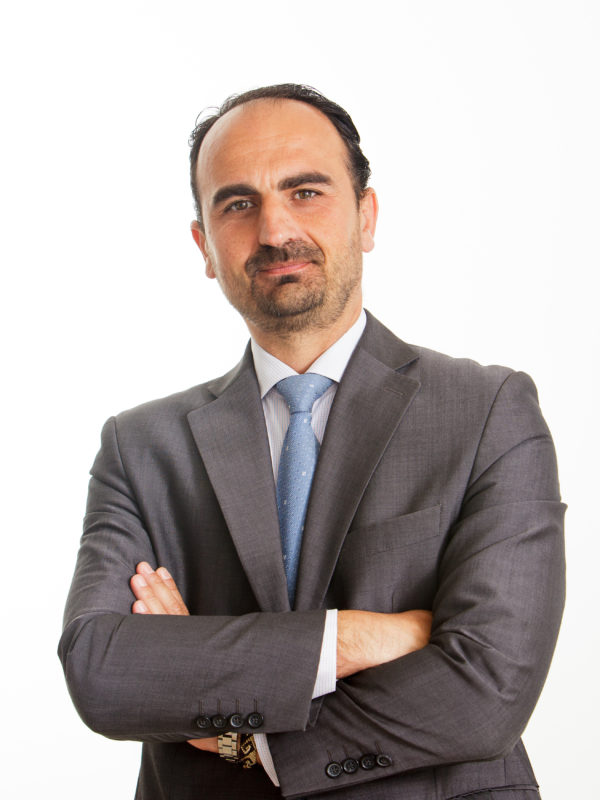
Image: Prodiel
Prodiel has been operating in the PV sector since 1994, in the early stages of development for solar energy. How has the company most changed since then?
Solar technology has advanced significantly, and the capex of the technology has changed a lot since we got started. In terms of scope, a 2 MW project was a big project in 2005. Today, our projects could be 100 MW and up. Most changes for our company from early-on projects have been in the logistics and the engineering.
Prodiel has continued to expand outside of Spain, with subsidiary locations in Chile, Colombia, Peru, Brazil, Mexico, Panama, Morocco, Kuwait, Guatemala, and Argentina. Can you talk more about your expansion in Africa?
We are all over Africa looking for opportunity. Prodiel is a company focused on large utility-scale projects – we are not doing projects below 15 or 25 MW. Right now, we are looking at Ethiopia with upcoming tenders. Senegal is always the hope, but the market hasn’t taken off yet. The Middle East is now proving to be a core market for us. With significant tendering in Saudi Arabia, the United Arab Emirates, Oman, and Kuwait, we are putting a lot of focus on these markets.
Are Latin America and Spain still the most important markets? What is next for continued expansion?
In terms of sales, yes. Spain is a market that is booming with large-scale projects, which is very exciting. For the next five years, we foresee five gigawatts being installed each year. Italy is also very promising right now. In Latin America, Mexico is significant, and accounted for about 40% of our sales last year. While things have changed, we believe that in the mid-term Mexico will be still be a strong market for us. Over the next two years, we still expect Chile to grow as well. While the Middle East will not be similar in terms of the sales that will be seeing in LatAm and Europe, we are very focused on the region. Australia will also soon be a new market where we will be actively working with industry partners.
Planning and building a large-scale solar plant is becoming an increasingly challenging business. How has your company continued to succeed through market challenges?
Prodiel has continuously focused on growing and expanding our internal expertise across all departments, from our engineering to tendering. Right now, we are staying on the cutting-edge of machine learning and digital technologies. We have remained at the forefront of technologies and markets, and then of course, maintain close partnerships with suppliers.
Can you speak to the level that your network of partners plays to ensure the bankability of a project?
This is definitely one of the main strengths of Prodiel. From 2008 to 2019, this industry has grown enormously, and our company has grown with the technology. We have long established, strong partnerships with the main equipment suppliers and industry stakeholders. It is crucial to work in collaboration with other partners and vendors to have the best equipment offering for investors. From concept to completion, projects create a long-term collaborative relationship that exists well after the installation is complete. We all have to work together as members of a team in order to develop excellent work.
How much does Prodiel rely on string inverters for your utility-scale PV plants?
We typically use string inverters for project plants with unique characteristics or challenging installation requirements. In previous years, we have installed more than 200 MW of PV projects using string inverters. In our pipeline, we have more than 300 MW of project capacity planned [utilizing] string inverters. We specify Huawei for string inverter projects.
What advantages has Prodiel found in using Huawei string inverters? In which markets are they used?
The main advantage is the production. Their reliability and strong performance in intense and unique environments has been extremely beneficial. We use Huawei inverters a lot in high desert areas. Having the ability to easily change the inverter if it is broken increases the reliability of the plant enormously. We have used Huawei inverters in Spain, the Middle East, and now Mexico. I think that the market will strengthen in coming years, and a higher percentage of projects will use string inverters. It’s all about bankability, and string inverters are here to stay.
French solar explorers acquire taste for Huawei inverters
After streamlining construction of photovoltaic arrays as far abroad as New Caledonia and Zambia, French developers are starting to roll out a new generation of inverters across their home market.
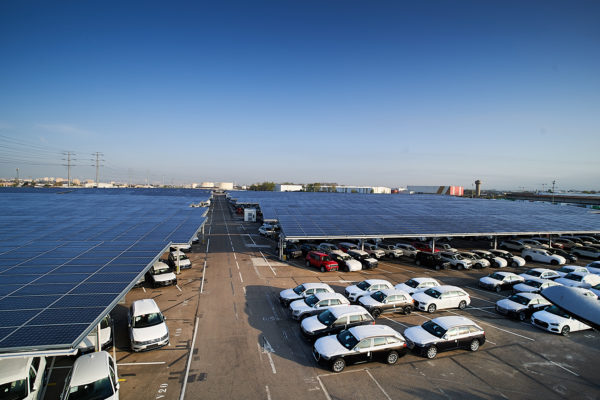
Image: Vincent Blocuquax
France is gently warming to the utility-scale projects that have come to dominate global photovoltaic installations, but according to Guirec Dufour, CTO of green energy producer Quadran, the French solar sector remains beset by regulation. He says that lengthy processes to obtain building authorizations, restrictions on the use of farmland, and exceptionally demanding national construction codes are typical French syndromes.
“European rules are not even good enough for us,” says Dufour. “We have to make up our own that are even more constraining.”
Over the past decade, Dufour has made a career of solving technical holdups on renewable energy construction sites. His efforts have been met with success. When he joined Quadran in 2008, he was one of just four workers. Following a period of brutal market consolidation, the firm has emerged with 250 employees, operating some 250 MW of solar plants, 500 MW of wind farms, and 20 MW of hydroelectric and biogas recovery units. Its achievements have attracted two acquisitions in the past two years, the latest from oil giant Total.
Quadran attributes its growth to the company’s agility in reaching new markets and implementing new solutions. The company has learned tricks in solving offbeat challenges that have given it a competitive edge in its core market. Two years ago, Dufour put this resourcefulness to the test when he set out to design the first 11 MW solar farm in New Caledonia, a French territory located in the South Pacific, 1,200 kilometers east of Australia – and about as far removed as geographically possible from Quadran’s offices in Béziers, France.
Further and smaller
“The time difference between headquarters and New Caledonia is nine hours,” Dufour says. “If you need to call someone in Europe, it is simply impossible.” That proved problematic. Conducting maintenance tasks on key components such as centralized inverters would typically require specialized technicians and heavy equipment that was unavailable on location and expensive to import.
“PV in New Caledonia basically did not exist two years ago when we started build- ing the plant. You couldn’t find trained personnel to maintain centralized inverters,” says Dufour, “And if you trained workers yourself, they were likely to go work for the competition in the following 15 days, leaving you constantly training new staff.”
Instead of meeting the human resource challenge head on, Dufour shifted construction of Quadran’s New Caledonia solar park to string inverters, which were lighter and easier to install than centralized. He connected all 43,000 solar panels of the project to the grid using 300 Huawei FusionSolar string inverters, each with a capacity of 33 kW.
“In the past, large projects had to adopt central inverters because decentralized inverters were not powerful enough,” explains Dufour. “Now, Huawei products can reach power outputs of up to 100 kW, so we can use string inverters on large plants too.”
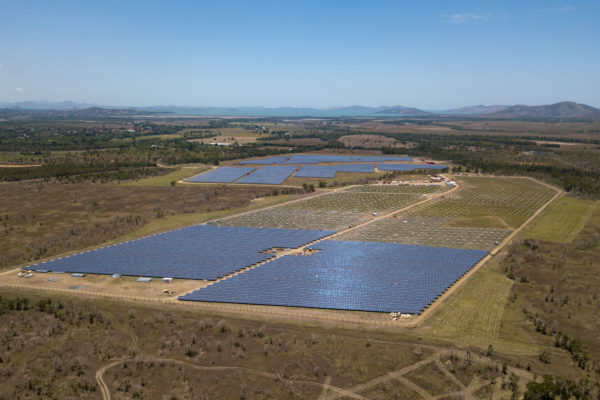
Image: Quadran
Smaller and simpler
In terms of maintenance, decentralized string inverters offer an advantage over central in that they require no specialized engineers or lifting equipment to install. Three workers can transport the hardware on-site by hand, and connect it without risk. If an inverter malfunctions, instead of flying in heavy equipment or representatives from its manufacturer to repair the device, local workers can simply unplug it and install a replacement.
“We just simplified everything in our solar plants using these inverters,” says Dufour, explaining that the entire fleet of Huawei products in New Caledonia have only recorded two faults since their installation. “They are much more reliable and require absolutely no maintenance. If we have a fault, we just swap the component.”
It is still early to quantify these benefits, but he expects that the string inverters in the project are drastically reducing its maintenance costs.
Since its experience in New Caledonia, Quadran has commissioned Huawei inverters to connect close to another 100 MW of installations both at remote sites and in mainland France. Among the technology’s perks, Dufour says that Huawei is the only supplier he knows of that embeds ICT in its inverter hardware to supervise plant operation. The product offers voltage of 800 VAC, reaches energy conversion efficiencies of 99%, and has helped meet French construction codes for stringing PV modules in parallel.
“Because you only have two strings per entry point, you don’t need to use fuses on the DC side. That makes the installation more reliable,” says Dufour, adding that higher AC voltages allow for lower losses on the connection to the transformer, avoiding the use of AC combiner boxes, and that the in-built ICT supervises the system with no need for additional monitoring equipment. “We just have an inverter and cables – that is it. That means less equipment, and less equipment means fewer faults.”
Simpler and safer
Xavier Barbaro, President of Neoen, France’s leading independent renew- able energy developer, agrees that the downtime of a PV plant is substantially reduced when using string inverters. To date, his company has brought 2 GW of solar into construction across four continents. For bankability purposes, Neoen signs turnkey engineering, procurement, and construction (EPC) contracts with its subcontractors, but it still specifies the subcomponents that it wants installed.
The company placed its first order with Huawei in 2016 after winning a 50 MW photovoltaic project in Zambia as a pioneer of the Scaling Solar program run by the World Bank. Treading new ground, Neoen wanted to anticipate logistical challenges by supplying the landlocked country with small and easy-to-deploy inverters.
“We paid a visit to Huawei in Shenzhen, China, not really knowing what to expect,” says Barbaro. “But we liked what we saw. In terms of manufacturing, it was really world class.” He initially valued the small scale of the FusionSolar inverter for the project in Zambia, and has since grown fond of its convenience and performance as well.
“Huawei has proven a reliable supplier with a very convincing product,” he says. “So far, we have had no issues with any of the Huawei inverters that we have installed.” Since 2016, Neoen has ordered FusionSolar inverters for some 300 MW of photovoltaic plants across Zambia, Argentina, and the largest carport installation in France, which it inaugurated in April 2019.
Safer and cheaper
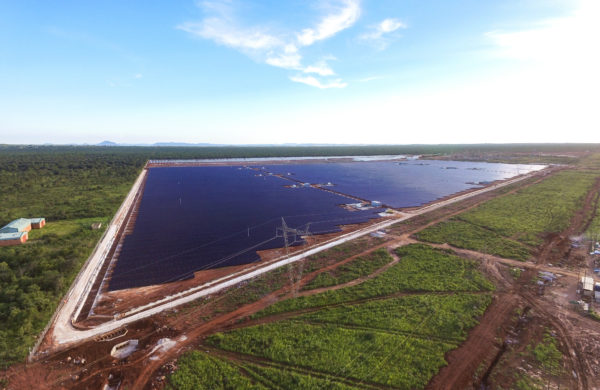
Image: Neoen
Barbaro says that simplicity offers advantages beyond construction sites, as lenders for Neoen’s renewable energy projects are cautious about the industrial choices that his company makes. He says that Huawei products have proven bankable, reassuring financial backers, and bringing down the overall cost of projects. “What we value is experience and expertise,” says Barbaro. “If you have dozens of gigawatts of installed capacity, you have a lot of experience covering a lot of different situations.”
Neoen is notably building a 200 MW solar plant in Argentina, located 4,000 meters above sea level. Not all inverters work at this altitude, but Huawei products have been deployed successfully under similar conditions in China.
“We tend to go with suppliers that can prove their point when they argue that their product offers the right choice for a situation that we face,” says Barbaro. “That is something that we have with Huawei.”
In today’s competitive market, Barbaro says that even curtailing financial provisions for inverters can have a decisive impact on the operation and maintenance budget of a photovoltaic project.
“Solar is now reaching prices under $20 per MWh, and that is really a game changer,” he says. “Every step in the project has been a part of that achievement, including the inverters. They represent 6-7% of a PV installation’s capital expenditure and play an even bigger role in its operating costs.”
Whereas capex optimization has dominated LCOE improvements over the past five years, Barbaro argues that “The next frontier is probably opex optimization, and there is a lot to gain from inverters in this area.”
“That is how we decided to also use Huawei inverters in France,” says Barbaro. “Of course, logistics in France is easier than in Zambia, but the product remains relevant.” He explains that FusionSolar is low-risk, user-friendly, and increasingly geared towards interoperability, concluding that “Huawei wants to make sure that their product is easy to package with substations and hardware coming from other suppliers,” and he concludes: “That is something that we like.”
European distribution insights
Wattkraft is a supplier and distributor serving EPCs and project developers. Francisco Pérez Spiess, Director of Technical Solutions and Sales at Wattkraft, talks about the European market and the company’s decision to exclusively offer Huawei for their inverter product offering.
Which markets have performed most strongly for you over the last year – Germany, the U.K., Italy, the Netherlands, or Spain?
Our home market is Germany, where our headquarters and our two German support offices are located. Consequently, we are much stronger in this market.
In the last quarter of 2018 as well as the first quarter of 2019 we have experienced a sharp increase in terms of sales volume, which some analysts believe is related to legislative changes and expect it to settle in Q2. Legislative changes are, in our view, not the only driving factor. We can also perceive a supply bottleneck in PV modules, which is potentially limiting growth to some extent. On the other side, the increased efforts from our distribution partners, as well as the new products launched by Huawei in the last year, have clearly contributed to an increase in market share – this is why we currently are quite optimistic.
In the Netherlands we have had a very strong increase in volume. Our team in Utrecht is highly successful in correctly understanding the needs of our distribution partners and their customers there, as well as in nearby Belgium. But not only in the commercial and industrial market segments are we performing well – we are also seeing a very healthy business in the residential and utility-scale market in those countries.
While the landscape in each market will vary from country to country, what market segment is most promising for you?
Wattkraft is very active in the residential as well as in the commercial and industrial market segments through its partner network, but we also have identified good opportunities in utility-scale plants.
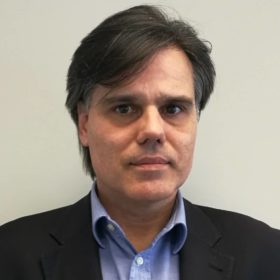
Image: Wattkraft
That said, Germany is our core market and legislation there favors PV plants below 750 kW, placing the focus on the commercial and industrial segment. Germany also has an active residential market, with a very promising evolution in the sales of PV systems which also include energy storage.
Precisely for this market segment, Huawei successfully launched last year its hybrid inverter family, called Smart Energy Centre, which is a PV inverter, with a battery interface, and the energy management and Wi-Fi communication to a mobile phone app and through the Internet, all in a single, lightweight device. It is a very exciting product, which is being well accepted in all European markets.
Very recently, Huawei also announced the market launch of its new three-phase inverter family ranging from 3 to 20 kW in power output, with extended communication capabilities. This family of products is the common link between the residential and the C&I market segments, as it addresses both.
Did you already experience a boost in sales resulting from the presumed “solar renaissance” in Europe?
Wattkraft is constantly increasing its market share through its distribution partner network in Germany, Benelux, Italy, Spain, and Portugal, where we are official partners of Huawei.
We all experienced sharp growth in terms of sales volume, and we believe that this not only happened because of the market evolution itself, but also due to an intense effort of all partners to bring Huawei into the market.
Although we are quite confident about the European market, we always try to keep in mind that in the past the solar industry has experienced high market dynamics, which comes from a strong legislative dependency.
The whole energy sector is quite strongly regulated in Europe, and the solar industry is being guided by political decision makers into the directions they consider more beneficial.
As political changes sometimes take place in a very narrow time period, the solar industry has registered some sharp movements in the past and eventually also will in the future, although we believe that frequency will decrease over time.
As a distributor you work with EPCs and project developers. Can you tell us what is of special interest to these customer groups, with regards to inverters, in the European markets that you serve?
EPCs and project developers have slightly different needs in the markets we serve – most of them ultimately derive from aspects related to legislative or technical requirements, financial questions, expectations on the return of investment, and of course risk management.
In relation to inverters, there are many points in common. For example [there is] a clear trend towards string inverters, a high interest in cloud monitoring solutions with cloud-based servers – even better if these are physically located in countries with strict data protection laws, as for instance Germany.
Digital communication features are very important nowadays, and for large EPCs the communications infrastructure is always an important cost factor, not only in terms of investment, but also in O&M. In this field, Huawei can offer either standard communication solutions, or more advanced communications directly over the AC cables. This allows cost savings and higher reliability, making sure that data collection and plant control can be kept fluent. For more advanced users, Huawei also offers an optional I-V curve analysis and diagnostic service that allows for identifying several potential problem sources on the modules. This is a very powerful tool for optimizing preventive and corrective O&M costs, not just during operations over the years, but also at the initial stage to identify commissioning mistakes which you would never be able to find or even realize without such a functionality.
Wattkraft specifies Huawei inverters exclusively. Why did you settle on this brand?
Opposite to other players in the market, Wattkraft decided to focus only on one brand. What we expected to achieve was a higher degree of specialization, improved added value for our customers, and a tighter commercial and technical relationship to the manufacturer.
Above all else, there is a very simple reason for us to focus on Huawei: Based on the low failure rate, the high yields, and the technical and financial background of the company, it is by far the best inverter you can get in the market.
A new kingdom
Saudi Arabia is turning toward solar technology with its first utility-scale project. The Sakaka PV installation is a testament to changing times in the global energy supply. The landmark 300 MW project is currently under construction, and will incorporate Huawei’s proven string inverter technology.
Saudi Arabia’s first utility-scale solar photovoltaic project, known as Sakaka, began construction in November 2018, and it heralds a new energy era in the kingdom.
The wheels began moving in 2016 with Saudi Arabia’s Vision 2030 strategy, a plan to pivot the kingdom away from its long- term reliance on oil. Saudi Crown Prince and Deputy Prime Minister Mohammed bin Salman (MBS) is credited with creating the vision, which has evolved into something much more comprehensive since those early days.
However, the country was up against memories of how an earlier plan from 2010 had failed to materialize – so why would this be any different?
The biggest reason was that this was the first time that the kingdom’s renewable energy strategy had been directed by the government.
Described as the “risk-taker,” MBS set forth a strategy aimed at increasing its renewable energy capacity three-fold with an initial target of 9.5 GW by 2023 (known as the National Renewable Energy Program). Another difference was that incremental targets were released under the National Transformation Program (NTP) of 3.45 GW by 2020, an investment that would require between $30 billion and $50 billion.
Progress continued just two months later with the creation of the Renew- able Energy Project Development Office (REPDO), a team falling under the energy ministry’s umbrella tasked with overall responsibility for the execution and delivery of the program. The division included members from every major energy entity in the country: Saudi Aramco, Saudi Electricity Company, Electricity and Cogeneration Regulatory Authority, and King Abdullah City for Atomic and Renew- able Energy. REPDO oversaw the tender process and immediately began work, with the Sakaka power plant as its first undertaking.
Companies began preparing for the 300 MW Sakaka solar power project after the request for proposals was announced in April 2017. By the time bids were announced six months later, eight consortia had submitted bids.
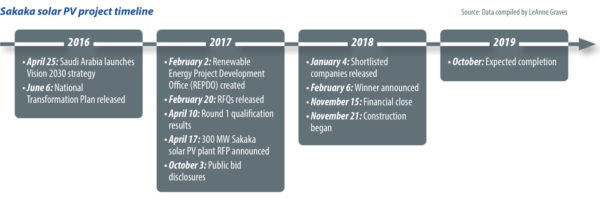
But in January 2018, the shortlisted bidders only included two companies: ACWA Power and Marubeni. REPDO said at the time that each bid had been “subjected to a detailed evaluation of material compliance to RFP requirements, including the 30% local content component for round 1 NREP projects,” and that the companies were invited to participate in future projects. This was the first time in the region’s solar tendering process that the lowest price consortium was not selected, and it piqued the interest of those that were previously wary of stepping into Saudi Arabia’s renewable energy sector.
That was the point when the Sakaka solar power plant had begun moving rapidly. The next month, the ACWA Power-led consortium with Al Gihaz Holding, was awarded the 300 MW project and a financial close was met in November totaling $320 million. A project company was created, Sakaka Solar Energy Company (SSEC), with ACWA holding a 70% stake and Al Gihaz the remainder. Through the project company, the 25 year build-own-operate power purchase agreement was signed with Saudi Power Procurement as the offtaker.
Domestic content
The first round of projects, which includes Sakaka, must have local content of at least 30%, which is not difficult for the chosen developing consortium, as both ACWA and Al Gihaz are Saudi firms. In addition, the chosen O&M provider, NOMAC, is also from the kingdom (and previously worked with ACWA on the Noor solar projects in Morocco).
Then ACWA decided to try something new in the region: string inverters. Historically, utility-scale plants on flat land have primarily specified central inverters. However, string inverters provide a different set of benefits.
String solutions provide more flexibility than central. And unlike one central unit, repairing or replacing a rogue string inverter is far less complicated and has much lower impact on the entire system.
ACWA chose to use Huawei as the sole supplier of inverters, using its FusionSolar 1500V Smart PV Solution which includes the SUN2000-90KTL string inverter and FusionSolar Smart PV Management System. This set solution will increase the energy yield by up to 2% while totaling the same capital expenditure required for central inverter systems. Huawei said that the decreased cost associated with operations translates to a lower levelized cost of electricity. Paddy Padmanathan, CEO of ACWA, said that string inverters are stable, with a shorter delivery time that could shave 10% off the overall total construction costs.
The Sakaka project is expected to be complete in October, providing enough electricity to power 45,000 homes in the Al-Jawf region, while offsetting 430,000 metric tons of carbon dioxide per year. And according to Padmanathan, the project could provide a blueprint for more string inverters being adopted throughout the region.
Shedding light on PV development in MENA
The Saudi-based energy giant awarded the landmark Sakaka project provides insights into the region’s growing PV market.
Paddy Padmanathan is the President and CEO of ACWA Power, an international developer, owner, and operator of power generation and water desalination plants carrying a portfolio valued in excess of $30 billion. The company has more than 29 GW of energy capacity installed across the Middle East and North Africa, South Africa, and Southeast Asia, and nearly 1 GW of solar PV projects installed in the MENA region.
What obstacles have you faced in the MENA region?
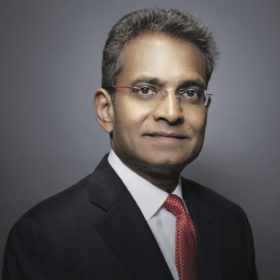
Image: ACWA Power
There is still a great deal of disbelief with people still questioning the technology. People are slow in coming forward and launching projects because they’re nervous. There’s still a misunderstanding to calculating the costs and in many instances, people aren’t calculating the amount of money they’re spending on current generation right now with fossil fuel plants. If they saw those numbers, they’d realize that it’s so different than what renewable energy can provide.
That said, what we are seeing are more entrants jumping into the market as it grows. There’s been about 20% more newcomers over the past five years – the companies have tripled. Every tender brings new people. If you look back at Dubai’s Mohammed bin Rashid Al Maktoum solar park’s second phase, there were 14 bidders. No one else has achieved that yet, but if you look, you’ll notice three or four of the same companies in recent tenders, but the rest are all new. Some come, try, and leave. Then they return. It’s a very dynamic sector right now.
What benefits have come to the region thanks to China’s Belt and Road Initiative?
China is reliable and a capable source of construction capacity. They’re also a competitive source of technology, with companies such as Huawei and Jolywood – who are capable, reliable, and cost competitive. And China can provide access to finance with a great deal of debt financing at the durations we need in a cost competitive way.
The notion that China is dumping cheap money is untrue. They evaluate in the same way as others, but the big difference is that China has the bandwidth to provide instant large sums. With a typical non-Chinese or regional lender, there will be a struggle to lend $50 million. In a $1 billion project where you need $800 million in debt, international banks will be hard-pressed to be able to provide $40-50 million apiece. The regional banks that have more capacity, perhaps they can provide $150 million. However, the Chinese can coolly write a check for $100 million.
Speaking of costs, what kind of returns on investment are you typically seeing with ACWA?
Electricity tends to be calculated in local currency. In places like Egypt, this matters. Once we take the currency risk away, these are all single-digit investments. However, once you have the currency risk, that puts you into the double-digit domain.
Returns on investment in MENA are comparable to elsewhere in the world. These are utility-scale projects and they’re essential. Utilities will think hard before stopping a payment or else the lights will go off, so the risk profile is very different.
Why did ACWA choose to incorporate string inverters on the landmark Sakaka project in Saudi Arabia’s Al-Jawf region?
String inverters are stable and have a slightly higher yield when compared to a central inverter solution. Other benefits include lower O&M costs, including a shorter delivery time which allows us to build the plant slightly faster. On an 18 month build, for instance, this could mean an overall 10% shaving off of costs.
Do you believe upcoming projects in the region will use this type of technology?
I don’t see why not. We will continue to use string inverters for sure, and I’m sure others will do the same.
What are your priority regions over the near-term?
We will continue to focus in markets where we already are, which are 12 countries. This year, we’re starting to look into Ethiopia as well as Uzbekistan, Kazakhstan, Senegal, Mauritania, and Botswana. We’d like to do more in Indonesia, Tunisia, and Vietnam. We expect to see a revenue growth of 20% year-over-year, but our target right now within the next five years is to double the number of countries we operate in and double the amount of assets we have contracted.
Full steam ahead for IoT in PV
Thanks to an energy system that increasingly converges between sectors, the deployment of smart management systems is creating a whole range of new business cases. In most parts of the world, this is stuff of the future with experimental trials, yet it is becoming more commonplace.
Never before has the energy system been more complicated than it is today. With increasing numbers of distributed generation assets, grid operators are tasked with ensuring the stability of the system – and continuing to do so at a competitive cost.
Solar photovoltaics has experienced a major uplift buoyed by global uptake in residential and small C&I assets. Over the past two decades, the European power system has increasingly featured more distributed assets, which have yet to be optimized.
Through ingenuity and the development of synergies between sectors, energy system engineers from around the world have found a way to not only offset the strain that variable renewable energy assets can put onto the grid, but to also use them in building network resiliency – at a price point more attractive than conventional methods.
In markets with a high penetration of distributed assets, the question of how best to accommodate the use cases of these assets has come up. Intelligent software solutions have been brought to the market by a plethora of power electronics companies, utilities, and other new stakeholders in the energy business. Solutions such as virtual power plants (VPPs), smart grids, and microgrids provide compelling examples of resilient and cost-effective grid infrastructure.
To pull this trick off, inverter manufacturers have started leveraging proprietary Internet of Things (IoT) applications into their equipment. According to IHS Markit nearly 11 million solar inverters will be sold in 2019, presenting an enormous number of data points which could add significant value to infrastructure if used smartly. Connect, collect, compute, and create: This is the new model for the energy ecosystem. The days of relying solely on poles and wire are over.
While still in its infancy, the market has already made strong use cases for VPPs, microgrids, and smart grids. A high degree of expertise in digitalization of the energy system has become a critical aspect for each inverter manufacturer to survive in the years to come.
Microgrids versus blackouts
One example for such new business cases is Finland. After a series of blackout events in 2011 and 2012, Finnish policymakers reacted by setting a price on power outages. Since 2013, distribution system operators (DSOs) have been obliged to compensate customers for grid downtime, staggered into six incremental increases depending on duration. For example, a single event outage of 12-24 hours will incur a 10% reduction on annual delivery fees. Outages of 120-192 hours provide a 100% discount, whereas outages of more than 288 hours will result in a 200% compensation. With this market mechanism in place, for many DSOs, it was simple to determine the cheapest option to address the issue: microgrids. Research performed by Lappeenranta University of Technology (LUT) found the lowest cost option for 10‒40% of medium voltage branch lines to be low-voltage DC microgrids, according to Navigant’s Peter Asmus.
Microgrid deployment will allow for interferences or damages to one part of the grid, such as snow on the power lines, without impact to other parts of the grid further down the line. Smartly managed distributed generation assets in each town and village can maintain base load power, even when power lines in a nearby village have collapsed.
Virtual power plants
Europe’s power grid can be further supported in stability through the implementation of VPPs. Grid ancillary services can be provided by virtual power plants at a price point more competitive than conventional means.A VPP is a network of decentralized power generating units tasked with balancing the grid, facilitating the integration of large renewable energy capacity into existing energy systems. With a central IT control system that can network and monitor all participating distributed energy resources, VPPs can be operated as traditional power plants with one big advantage – flexibility. As the cloud is fed with all information about the interwoven units and the power grid, VPPs can assume a role in frequency regulation, and also adapt to the continuously changing electricity price when selling output on wholesale markets. In some European markets, VPPs are already allowed to provide grid ancillary services, and the financial out- look is promising. The German regulatory authority, Bundesnetzagentur, publishes its monitoring report which lists costs for grid ancillary services in the country each year. In 2017, these costs came in at close to €2 billion. The cost to provide primary, secondary, and tertiary balancing reserve is about €145 million. A considerable portion comes from compensation for curtailment at €609 million and re-dispatch claims of €291 million.
With virtual power plants, grid operators can tap into distributed solar assets to tackle these costs for a fraction of the price. The EU’s new clean energy package foresees a slow turn toward market-based approaches for curtailment and re-dispatch. The package identifies the vital role of VPPs and permits their use in ancillary service markets. As of now, policymakers have not yet paved way for the technology to address the costly issues of re-dispatching and curtailment. However, the path could be inevitable.
Rural electrification mini-grids
For more than one billion people in the world, electricity remains unattainable or limited. With economic development and modern health services hinging on electrification, this creates severe impacts on the lives of a large proportion of the planet. The UN has put electricity supply far up its agenda in its Sustainable Development Goals. Distributed PV projects working as mini-grids are a cost viable solution to addressing the global electricity challenge. The generation assets are cheap, have low operating expenses, and do not require the expansion of grid infrastructure to remote corners of a country.
Strategic investment growth in off-grid solar, mini-grids, and universal energy access projects are climbing. A report by analyst Wood Mackenzie shows sector commitments climbing, with a 37% increase from 2016 to 2017 and a 22% increase from 2017 to 2018. Last year’s investment volume clocked at $511 million. Until February 2019, nearly $1.7 billion had been poured into the sector. In 2017, Huawei developed a rural electrification project with Cameroon’s Water Resources and Energy Ministry. The smart PV solution provider contributed to a scalable solar, energy storage, and diesel generator solution. After completion of the first phase of the project, Huawei’s Microgrid Solar Solution now provides 166 remote villages electricity to the benefit of more than 120,000 people.
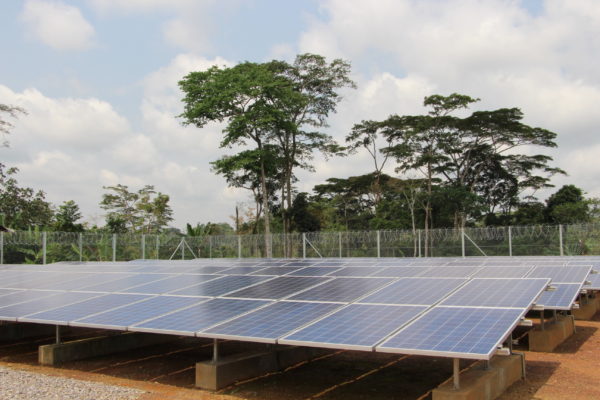
Image: Huawei
Distribution solution
Huawei launches its next generation smart inverter, tailored to C&I and rooftop installations. At The smarter E Europe 2019 in Munich, Huawei launched a new residential and commercial iteration of its proven FusionSolar Smart PV solution. The three-phase inverter’s innovations promise quick installation and a range of artificial intelligence (AI) features for safe operation and easy energy management down to the module level.
The FusionSolar Smart PV Residential & Commercial Solution is the latest addition to Huawei’s comprehensive offering for the solar industry, completing this product line by providing expansion to cover the C&I solar segment. As prices for solar continue to fall, companies are increasingly interested in sourcing their own electricity, creating a boom for this segment across the globe.
But C&I solar installations bring plenty of challenges to technology providers, from optimizing energy yields and integrating storage, to ensuring safety and security where rooftop installations are placed close to populated areas and on top of valuable buildings. “The distributed rooftop structure is complex,” explains Bin Xie, Director of Huawei’s Smart PV Business Unit. “And there are still many opportunities for improvement in the commercial PV segment.”
Huawei’s solution aims to meet the specific demands of this fast-growing segment through a range of innovative features focused on safety, ease of installation, and simple operation and energy management assisted by artificial intelligence. While launched globally at The smarter E, initial focus for the product will be on European markets, with high demand also expected in Australia.
The core of the offering is Huawei’s SUN2000 inverter, which for the C&I solution is available in 10 different capacities, recommended for installations between 3 and 20 kW, with maximum efficiencies in the range of 98.2-98.65%. All of the extras that Huawei’s FusionSolar Smart PV solution is known for are incorporated, such as IP65 protection for outdoor installation, fanless cooling for increased reliability and compatibility with energy storage solutions, and module level optimizers. The solution operates at a volume of 29 decibels, which Huawei describes as ‘library level noise.’
Easy installation
Weighing in at as little as 17 kg, Huawei’s C&I inverter is smaller and lighter than many of its competitors, and there is no need to open the cover during installation. The company says this means it can be installed and set up by just one person, saving on time and costs.
To ease the installation process even further, Huawei has integrated several AI features to its commercial offering. Bringing its experience as a leader in the telecommunications industry to its solar solution, Huawei integrates a HiSilicon chipset with multiple channel signal modulation and transmission features – which it says will bring the time for optimizer pairing down to less than one minute.
Using AI image recognition technology, the solution is able to identify the component location and the optimizer QR code – automatically generating the physical system layout view. This significantly reduces time allocation, from more than 20 min- utes to less than five seconds, according to company representatives. Huawei’s Smart I-V curve analysis is able to identify multiple system faults at the touch of a button, with no need for additional inspection.
Safety
Fire safety is a key concern in rooftop PV, and in many leading markets regulations are emerging that require system suppliers to integrate functions such as module- level rapid shutdown to reduce the risk of electrical fires. With its new commercial solution, Huawei has gone far beyond these requirements with an AI innovation that it says can detect increased risks before they escalate, and isolate parts of the system to prevent fires before they occur. “Rapid shutdown technology can reduce the voltage to the safe standard in the initial installation and future maintenance scenarios,” explains Xie. “But fundamentally, it cannot eliminate the risk of fire.”
This is where Huawei’s arc-fault circuit interrupter (AFCI) comes in. Using AI, the solution can detect arcing within the system, and automatically isolate and shutdown the faulty inverter completely until the problem is resolved.
Arcing is one of the most common faults leading to fires in a PV system, often caused by breakdown of conductor continuity and system insulation – common problems as PV systems age. The electrical breakdown of air that produces a prolonged electrical discharge can reach temperatures of more than 3,000 degrees Celsius. This problem primarily occurs on the DC side of a system, as it requires continuous voltage and other conditions not found on the AC side of a system.
To mitigate this risk, more and more systems include inverters with an AFCI capability. But the detection methods deployed vary, and distinguishing actual arcing from other noise in the cable caused by switching circuits in the inverter or even other appliances such as neon lights or vacuum cleaners can be tricky, leading some solutions to suffer from frequent false alarms and nuisance tripping, reducing the system’s efficiency without any real safety concern.
Huawei’s FusionSolar Smart PV Residential & Commercial solution employs an innovative, AI-driven method for arc fault detection. According to Huawei, the system can identify a wide range of signs that point to arcing and is also able to ‘learn’ and accumulate characteristic parameters, improving its ability to reliably and accurately detect arcing anywhere in the DC line. The system also features a confirmation mechanism to protect against arc faults, and to effectively eliminate nuisance tripping.
Monitoring
Huawei’s commercial PV solution is packed with features designed to give system owners insight and control over their energy consumption, as well as to minimize operations and maintenance requirements, and protect the system itself from damage and degradation.
Huawei’s inverters also feature built-in PID recovery, which in testing conducted by Hasselt University’s research institutes, IMO and IMOMEC, showed that a module which suffered 93% degradation after 96 hours in a testing chamber at 60°C, 60% relative humidity, and 1000 VDC, degraded just 22% under the same conditions with Huawei’s PID recovery. The built-in PID recovery feature reduces output loss by up to a staggering 70%.
New arrivals are flirting with batteries
As the market evolves, so are the products. New arrivals for the residential sector are showing a focus on communication standards and storage readiness, two features that are becoming more important for the energy system of the future.
Huawei’s suite of residential products has broadened with new arrivals in the first half of 2019. In the scramble to find more rooftop spaces to be retrofitted with solar PV, system designers have been met with the challenge of partial shading and otherwise arguably unsuitable rooftops.
Huawei’s Smart PV Optimizer SUN2000-375W-P2, in combination with the company’s new Smart Energy Center Sun2000-3-10KTL-M1 (3-10 kW) and SUN-12-20KTL-M2 (12-20 kW), promise to address the issue. The new residential products allow module level power electronics to be fitted only to the individual solar panels that are subjected to unfavorable orientation or partial shading.
Instead of fitting 20 or more PV optimizers to offset shading challenges, it would now be possible to fit them, for example, only to the four modules that are affected by the nearby tree or chimney. This further reduces the cost of the system, increasing PV’s competitive edge in many markets.
The optimizers use DC cabling for communication with the inverter and other associated power electronics, which improves the security of the communication standard against wireless solutions, and eases installation when compared to designated communication cabling solutions.
The new inverters weigh about 17 kg for the 3-10 kW option and 25 kg for the 12-20 kW inverter. Thanks to this high energy density, outperforming that of many competitors, Huawei says that its inverter can be installed by one person alone. Setting aside the lower weight of the inverter, the company also touts that its new generation of inverters also has an improved cabling interface. The new interface allows installation of cables without the removal of the inverter cover, which is required for most other inverters. This not only helps to further reduce installation costs, but also improves the ingress protection, avoiding installers fiddling with the factory condition of the equipment.
Leveraging its expertise in telecommunications technology, Huawei has fitted its new inverters with 4G dongles, ensuring stable Internet connection from the inverter to the energy management system. This could be particularly helpful in carport installations or projects where the inverter is installed out of reach from a homes’ Wi-Fi connection.
The inverter is battery-ready, requiring no additional power electronics or new cabling should the owner decide to retro- fit a battery storage system. With feed-in tariff regimes fading out in many markets, the question of self-consumption or finding alternative revenue streams for prosumers has come into new focus. Most new use cases, such as integrating PV systems into virtual power plants or operating home appliances to improve self-consumption, require the flexibility that is provided by a storage system. While still prohibitively expensive in many markets, battery systems will become of greater interest for many system owners within the lifetime of their installation, making an easy retrofit an important feature in a hard-fought inverter marketplace.
Huawei goes home
Residential solar: Since entering the solar inverter space in 2011, China’s Huawei has enjoyed rapid market share gains in all utility-scale and commercial markets in which it has competed. Now, as the many mature solar regions begin ramping up residential, Huawei is poised to introduce new technology solutions for this expanding market.

The overarching theme from 2015’s COP21 UN Summit in Paris was finding viable ways to limit CO2 emissions to prevent the earth’s temperature increasing past critical mass levels by 2050. Heads of state shook hands, signed documents and posed for pictures before the world’s media, emerging triumphant in their belief that their words, promises and pledges could prove pivotal in this fight.
Strong, stable leadership has a huge role to play in keeping climate change at bay. But top-down actions always run the risk of alienating masses of people, and effecting behavior change en masse is not only fraught with contradictions, but is nigh-on impossible to achieve in a functioning democracy.
The battle against rising CO2 emissions has long been, and remains, economic. During the recession, western nations actually saw their emissions flatline or fall in line with tumbling consumption, while the great worry among environmentalists is that, as nations with huge populations become more developed, their emissions are going to push past the point of no return.
So the question of how best to tackle climate change is not one of ideology, but simple economics: if clean power sources can become cheaper, then the whole world benefits. And this is what has happened with solar in recent years. At the utility scale at least, solar PV plants have reached grid parity, and in some cases are even cheaper than gas or coal. Maturing solar markets are now bringing their innate ability to drive down costs to bear on the residential space. Where previously home solar was supported by necessary subsidies in order to prove attractive to cash-conscious homeowners, now costs are so low in many leading markets that typical rooftop solar systems make economic sense on their own.
In the U.S., Japan, Australia and most parts of Europe, residential solar installations are poised to be the chief drivers for PV growth over the next few years, and it is this opportunity that has piqued the interest of Huawei. The Chinese firm has already proven a disruptive presence in large scale solar markets, and analysts are confident that their entrance into the residential space will prove telling in a number of ways – not least in driving costs down further and, in turn, increasing uptake of solar PV.
Huawei’s offering
The string inverter portfolio offered by Huawei is evolving. At the recent PV Expo in Tokyo the company showcased its new 33 kW and 40 kW inverters that boast four maximum power point trackers (MPPT), two DC switches and eight strings each. These iterations have been designed for the commercial rooftop market and weigh 55kg each, but the firm also unveiled its range of smaller inverters ranging in size from 4.12 kW and 4.95 kW, weighing 10kg and easily groupable for installation on 50kW small commercial rooftop and free field installations.
With such flexibility in size and scope, talk has obviously turned to Huawei’s residential ambitions. “We have enjoyed a lot of success in the commercial rooftop markets of Europe, Japan, the U.S., China and the APAC region,” a Huawei spokesperson told pv magazine. “So as requested by our customers, and driven by the development strategy of Huawei itself, we will expand our product portfolio to residential markets. This will be an important year for us to have a global launch of residential products in Europe, Australia, China and the U.S.”
The new residential inverter from Huawei is a rather sleek, smooth-edged appliance that has evidently been designed with the style-conscious homeowner in mind. It is lightweight, so can be easily installed, and comes battery-ready for those homeowners who wish to add storage capacity. As with all Huawei inverters, it will also be compatible with the FusionSolar APP, meaning homeowners can quickly and simply monitor their solar energy production.
“This new inverter has already won a Red Dot design award, having impressed the judges with its smart home design,” said the Huawei spokesperson, who remarked of the importance of developing different applications and products for different scenarios and solutions. “How to manage solar PV, storage and self-consumption in the home is a different challenge for us. This is why the new inverter is being presented as part of our new smart home energy management center.
“Secondly, it is challenging to create a partner sales network and pull-push power in the residential market. But the Huawei brand is becoming more and more well-known thanks to our smartphones.” With this in mind, Huawei is aiming to become a leader in the residential solar PV industry in a similar way that companies such as Tesla have used their excellence in other fields to create hype and demand for their home energy solutions, namely the Powerwall battery.
However, Huawei is acutely aware that style requires substance. “Our brand pull power will be really helpful for entering into residential markets,” said the spokesperson. “But quick and reliable service is a must in this market. We believe that it is premier quality and efficient services that ultimately win the trust of our clients, which is why we have a dedicated service channel in our portal system to support our customers intelligently and efficiently.”
A numbers game
The growth in the uptake of module level power electronics (MLPE) in recent years has been almost exclusively rooted in rooftop solar sectors. The slight efficiency gains proffered by the use of DC optimizers and microinverters make sense at this smaller scale, the additional 2-3% yield a viable trade-off against the costs associated with installing such technology. At utility-scale, the cost benefits are not quite there yet, however. Hence, with further opportunities for homeowners and businesses to increase their solar energy yield, one can expect growth in this sector to continue rising sharply – and again, Huawei is awake to the possibilities at hand.
“We are making investigations into the [MLPE] markets and assessing the best options,” Huawei’s spokesperson confirmed to pv magazine. “The new NEC2017 safety code in the U.S. mandates rapid shutdown of modules on rooftops, and this is making the argument for MLPE more compelling than ever. In other markets, we see similar trends of safety requirements and demand of module-level monitoring. The challenge for Huawei is how to create value for our customers with balanced cost and long-term reliability. But we have confidence in our unique ability to overcome those challenges.”
It is expected that Huawei will introduce to the U.S. market DC power optimizers in the second half of this year, with further markets added later in 2017.
A key tenet of this growth will be identifying viable partnership networks that can ably support Huawei’s expansion strategy and service standards. Residential solar markets tend to be less easy to regulate than utility-scale markets, which are often dominated by smaller clusters of suppliers and EPCs.
“As market opportunities in distributed generation emerge, along with the launch of our residential products, Huawei will continue to explore more partnerships and rapidly expand the number of trusted partners to reach more cities and towns and to be closer to our customers to offer them the best products and services,” concluded the Huawei spokesperson.
A string of success
String inverters at scale: The global solar industry has seen in the past few years how string inverters are increasingly displacing central inverters in multi-MW PV power plants. pv magazine examines the benefits of this shift, and what the future may hold.

In 2011 the first multi-MW PV power plants equipped with string inverters were commissioned in Germany, proving that all grid-code requirements for large scale solar systems could be met with a distributed inverter topology. and not only by central inverters.
String inverter topology for MW-systems initially used for “special” layouts
Ever since, three-phase string inverters have seen a growing adoption rate in large scale PV power systems. Initially the key driver for the increased adoption of string inverters in utility scale systems was the fact that switching to string inverters gave the EPCs a much higher degree of freedom in the plant layout. In incidents where the plot of land was not simply flat, where (partial) shading was an issue, where modules with different power ratings had to be integrated in one PV system or simply where the access roads would not support the heavy load trailer trucks required for bringing the central inverters onsite, the switch to string inverters was decisive to make the PV project viable at all. In such incidents the higher investment costs that the use of string inverters still meant 2-3 years ago could then be justified.
In the meantime, the price differential on a €/kWp basis between central inverters with a power rating in the MW-range and three-phase string inverters with a power rating in the 30 – 60 kW-range has diminished strongly.
As a consequence, more and more developers and system engineers of solar power plants are deciding in favor of the decentralized inverter layout even in the absence of specific incidents that would necessitate the use of string inverters for an efficient layout of a multi-MW solar power plant.
Taking only the investment and constructing costs into account, equipping a 20 MW power plant with string inverters is no longer necessarily more expensive than with central inverters. For the string inverter layout the added cost for the transformer cabin and AC-combiner boxes have to be taken into account. On the other hand, no DC string monitors are required for the string inverter layout and significant savings can be realized at the DC-cabling level.
Yet the budgeted costs laid down in spreadsheets don’t necessarily reflect real life challenges involved in the construction of PV power plants. Stefan Koeberlein, senior manager at German EPC firm sun.factory GmbH highlights: “We usually have very tight schedules for the construction of the PV power plants. Often enough regulatory frameworks impose deadlines that under all circumstances have to be met. Since the installation of a central inverter requires renting expensive equipment and coordinating specialists, this can cause quite a headache and extra costs, if the weather conditions force the rescheduling of the originally planned installation date. Going instead with string inverters provides us with the option to react much more flexibly at the construction site to any external factors that force adjustments to the original time schedule.”
String inverters grant flexible service concepts and lower maintenance costs
Today, the most frequently cited reason why operators and owners of PV power plants opt for a string inverter configuration instead of a central inverter solution is the flexibility in the service concept.
With a central inverter architecture the operator is bound to this specific manufacturer for service and spare parts for the entire lifespan of the PV power plant. Furthermore, certain parameters of a central inverter can only be accessed and modified by authorized service technicians. If a problem with a central inverter cannot be solved remotely a qualified service technician of the inverter manufacturer has to travel to the site to perform the repair. In case the cause of the inverter problem could not be diagnosed remotely, two trips to the power plant are required: the first to identify the cause of the malfunction and the second for the actual repair. Depending on the location of the power plant and the availability of the given spare part, significant additional costs can arise from expediting the required replacement part to the site.
The whole time before the repair of the central inverter can ultimately be performed, the thousands of modules attached to the central inverter are affected by its underperformance, thus leading to substantial energy yield losses.
In contrast, the service concept for string inverter configurations has always been that local electricians simply replace the faulty inverter in the field and send the defective device back to the service center of the manufacturer where the fault analysis (and possibly the repair) is being performed. The local electricians only have to be qualified in (dis-)mounting and (dis-)connecting a string inverter, which for modern string inverter designs is fairly simple. This allows for much lower servicing costs and much faster reaction times. Even if the servicing time for the central inverter and the string inverter were the same, the effective loss in power generation would be 20 to 50 times lower per inverter failure.
With failure rates of Huawei’s string inverters below 0.5% per year statistically there will be no more than one inverter service incident per year per 10 MW PV power plant unit each equipped with 200 string inverters. The larger the size the solar power plant gets, the more remote typically their location, clearly favoring the decentralized inverter concept in particular for the largest solar power plants. Indeed, the largest PV power plant to date is a 1 GW system in China equipped with Huawei string inverters.
Even more concerning than the servicing costs for central inverters is the complete dependence on the supplier. What happens if a manufacturer discontinues its inverter activities within the next ten or 20 years? If today a power plant operator requires any kind of support for a Satcon central inverter, for instance, he has to be prepared to pay exorbitant service fees, since Satcon went out of business a couple of years ago.
In contrast, if a solar power plant is equipped with 400VoltAC string inverters today and the original supplier is no longer active ten years from now, there will always be a choice of 400VoltAC string inverters from alternative suppliers that can be used at that time to replace any faulty devices of the original supplier.
And consider an alternative service scenario: Suppose for whatever reason ten years from now multiple solar modules have to be exchanged at the power plant. It is obvious that today’s power ratings of the modules will no longer be available. With a central inverter architecture there is no chance to take advantage of the higher power ratings of the modules available by then. With more than 2,000 modules per maximum power point tracker (MPPT),
Huawei has made great progress in the cost optimization of string inverters, resulting in negligible price differences
Huawei provides a unique advantage – smart fault detection
All of the above cited arguments that have already led to string inverters capturing an ever growing share of the utility-scale solar system market can be summarized with the terms of flexibility and vendor independence. For an asset that has to operate for 20 years or more in order to earn the intended investment yield, flexibility and vendor independence are good arguments by themselves to opt for this architecture. Yet Huawei is now introducing an argument that is unique to its architecture and cannot be replicated in a central inverter power plant layout.
All Huawei string inverters with power ratings above 36 kW launched since last summer are capable of performing a smart fault detection and diagnosis. How does that compare to the current state of the art?
As of today, the monitoring of a solar power plant is limited to monitoring the output power and comparing it to the expected power yield based on the irradiation level measured in parallel. In a central inverter topology, even when using smart DC combiner boxes the inherent measurement uncertainty of around 2% -3% limits the ability to detect all relevant faults in a solar installation as long as they only affect single strings or modules.
With a conventional string inverter topology, underperforming strings can be identified yet without any further insight into the cause of the underperformance.
Compared to the central inverter architecture at least one has the advantage of being able to better localize the affected areas within the solar park.
If the observed energy yield loss is severe enough to trigger a further analysis, in both scenarios it is required that a service team is dispatched to the site of the power plant and that it performs time intensive and costly measurements on-site, be it I-V curve measurements, electroluminescence measurements or thermal imaging. Often enough the detailed analysis of the field measurements is then performed back in the office, requiring a second service incident on-site to perform the actual repair. Consequently, the time that elapses between detecting an underperformance in the field and its repair can easily exceed one week.
Given the high costs associated with each diagnostic tests performed on-site, operators have to set significant thresholds before an on-site visit of a service technician can be justified. Therefore, a key economic requirement in day-to-day solar power plant operation is limiting false alarms.
All these issues can be solved with the use of Huawei’s FusionSolar Smart PV Management System. From the remote monitoring center an operator can initiate with a simple click the I-V curve scan of individual strings. Intelligent diagnosis algorithms can not only identify faulty strings but can also distinguish between more than 15 different causes for the underperformance listed in the table below. In order to perform the fault diagnosis, Huawei’s software identifies typical I-V curve signatures associated with the specific faults.
| Open circuit of string |
| Current mismatch in string |
| Panel shadowing |
| Glass breakage of panel |
| Hidden cracks in panel |
| Panel cover up |
| Cell damage in panel |
| Diode short circuit |
| Bracing breakage in panel |
| Low string voltage |
| Risk of PID |
| String with minor current mismatch |
| String with high resistance |
| Low string short circuit current |
| High decay speed of string |
| Incorrect string configuration |
Table 1: list of different fault causes Huawei’s FusionSolar can identify
From an operator’s and an owner’s perspective, such a remote fault analysis bears a number of important advantages:
- No service technician has to be dispatched to perform the error localization and error identification on-site.
- The fault diagnosis can be performed any time, independent of weather conditions.
- The actual measurement is performed within a few seconds so that the time between error identification and repair can be drastically shortened.
- No modules have to be disconnected for the failure diagnosis, and so no energy production has to be sacrificed in order to perform the failure diagnosis.
- The thresholds in the monitoring system that trigger an error analysis can be set much tighter, as no additional costs are associated with the failure diagnosis. Thus, underperformance can be identified at a much earlier stage, further improving the overall energy yield of the solar power plant.
This feature is a clear differentiator and has the potential to significantly increase the adoption rate of Huawei string inverters in utility-scale solar parks around the world. Looking at today’s success of Huawei in a stagnating European solar market, increasing its shipments from 400 MW in 2014 to some 800 MW in 2015 and more than 1.5 GW in 2016, the intelligent failure diagnostic feature is bound to spur further growth in the next few years.
So far one can distinguish quite different adoption rates of string inverters in the utility scale market segment globally. It is estimated that in 2016 roughly 50% of the newly installed PV power plants in China were equipped with string inverters. In Europe, anywhere from 15% to 25% of the MW-scale PV installations last year used string inverters while in the U.S. string inverters still made up less than 10% of the utility scale market.
Huawei’s introduction of the intelligent failure diagnostic feature at the inverter level will significantly impact what in future will be expected from operations and maintenance (O&M) of solar parks. On the back of Huawei’s success, string inverter-equipped large-scale solar parks could become as common around the world as the already are today in China.
FusionSolar: a top runner in China’s energy evolution
The Top Runner Project: Huawei’s string smart string inverters and FusionSolar solution is proving its worth in China’s Top runner Project, which is slowly but surely ushering in a new, cleaner energy future for the country.

Datong, in Shanxi, China, is an important coal-producing region. Unfortunately, the water and soil in some areas of the city has been irreparably damaged due to coal mining, and the land is no longer suitable for farming. However, what this land does have is huge potential for producing solar energy, with an annual solar irradiance of 5,432.8 million joules per square meter. Within China, this is second only to the Tibetan Plateau, making Datong an excellent location for the construction of PV plants.
In April 2015, the Shanxi government sent an official report to China's National Energy Administration (NEA), proposing the construction of PV power generation bases at mine subsidence areas in Datong. In June that year, following the proposal's approval by NEA, the first PV Top Runner base of China was settled in Datong. A year later, the National Development and Reform Commission (NDRC) announced that, starting from June 30, 2016, the feed-in tariff (FIT) would be lowered. The plant shareholders of the Top Runner project all accelerated the project progress and hoped to complete before the deadline. On June 29, 2016, the first phase was finished on time, with 1 GW capacity being completed, installed, and then connected to the power grid to begin production. The incredible construction speed demonstrated by the Top Runner project shows its leading place within the future of solar energy.
Intelligent and cost efficient power generation were critical factors for the investors that won the bidding in the first phase of the Top Runner project because they directly correlate to the return on investment (ROI) for the shareholders. In the contest of cutting-edge technologies and products in the PV industry, the enterprise that focuses on the technologies that will improve energy efficiency and has strong brand appeal is certain to be the winner.
Seven enterprises including CHD, CGN, United New Energy, and CTG New Energy each won the bid to develop a 100 MW PV plant of the Top Runner project. Another five enterprises including Jinkopower each won the bid to develop a 50 MW PV plant. Following the innovate application of the Huawei FusionSolar Smart PV solution at mine subsidence areas, ten mainstream developers chose to team up with Huawei. These developers made use of Huawei's smart string inverters and FusionSolar solution, and all were successful in creating grid connections without any faults. In total, Huawei has supplied 500 MW inverters to the Top Runner base in Datong, accounting for 50% of the Frontrunner project's total capacity.
Smart string inverter
Only PV modules and products with an efficiency level that is at or above the industry benchmark can be shortlisted for use at the Datong Top Runner base. An inverter must have a conversion efficiency of more than 99%, a Chinese efficiency of not less than 98%, and the capability of zero voltage rides through (ZVRT). Considering the challenging mountainous terrain and the difficulties with O&M in mine subsidence areas, plant investors favor string inverters and intelligent O&M systems.
Wang Yanguo, a senior engineer of Shanxi Electric Power Engineering Co., Ltd., conducted a site survey on the geological environment of the mine subsidence areas in Datong. He concluded that the challenging terrain can cause inconsistencies with PV module orientation, decreasing energy yields. Other factors such as continuous and uneven subsidence and too much ash can also increase the chance of a PV module mismatch. Fan Xiushan, general manager of the North China Region of CTG New Energy, a company that has cooperated with Huawei several times, said: “String inverters succeed in reducing the energy yield loss caused by the shade that PV modules can be under when deployed on mountainous terrain, compared with central inverters under the same conditions. This ensures an improvement of more than 81% of plant PR and 4.62% of energy yields.”
Of the 10 developers that use smart string inverters, CGN and United PV use only Huawei smart string inverters; 95% of the inverters used by CTG New Energy are Huawei smart string inverters, and 80% of the inverters used by Jinkopower are Huawei smart string inverters.
Meng Yaqi, vice general manager of the Inner Mongolia region of CMN, praises the terrain-based PV array deployment supported by the string inverter solution. String inverters are ideal for outdoor use because the IP65 rating and free cooling design can completely protect string inverters from ash. This eliminates the need for some maintenance tasks such as cleaning up dust.
Coincidentally, CHEC has also chosen to use string inverters, which improve the efficiency using precise maximum power point tracking (MPPT) technology and increase energy yields using a solar tracker. Li Yanhong, chief design engineer of CHEC, said: “Dust accumulation greatly reduces energy yields. Due to the location within an area previously used for coal mining, the time taken to clean a PV plant is twice that of a normal PV plant. Thanks to Huawei's smart PV O&M platform, which works in unattended mode and requires only a few maintenance personnel, the O&M cost is reduced while the efficiency is greatly increased. This leads to ‘lower investment, higher return', making this an economic project.”
Intelligent O&M
To withstand tough terrains and harsh demands, Top Runner project shareholders and EPC units spare no effort to ensure that they have the best device models. This is particularly true when selecting PV modules, inverters, combiner boxes and box-type transformers.
Furthermore, many shareholders have higher requirements regarding intelligent O&M than they
do regarding energy yield increase. A convenient and efficient O&M system can function as the “brain” of a PV plant. Many shareholders are now collaborating with Huawei to construct intelligent O&M networks across regions, countries, and even the world.
Jinkopower was one of the developers involved in the first phase of the Top Runner project. Jinkopower undertook a 50 MW project in Dongtiaojian, Dianwan, Zuoyun. Gong Chuanhe, president of Jinkopower Design Institute, tells us that a medium-sized (for example, 50 MW) PV plant requires a far more complicated management unit than a small-sized PV plant. The O&M system must be intelligent, efficient, and reliable, and support systematic and centralized management. When selecting such an O&M system, shareholders will consider the pros and cons for devices, intelligent inspection, and power generation efficiency.
CGN has also chosen Huawei FusionSolar Smart PV Solution for its 100 MW PV project in Xingwang, Datong, Shanxi. A technical engineer from CGN said: “The 100 MW PV plant covers an area twice as large as that of a normal PV plant, which makes manual inspection an impossibility. The FusionSolar Smart PV solution can precisely monitor the running status of each PV string and accurately locate any faults, greatly reducing the time required for checks. Therefore, we decide to team up with Huawei to set up a remote centralized control platform. We will build provincial monitoring systems to implement hierarchical control and reduce site O&M personnel.”
CMN is also optimistic about the future of the smart PV strategy. The head of the Frontrunner project team of CMN announced that “when designing the intelligent O&M, ideology for PV plants, high reliability, high intelligence, high automation, high efficiency, simple system, easy maintenance, and internet-based design are all critical. The Huawei FusionSolar Smart PV solution meets all of our requirements.” CMN has been involved with co-constructing an intelligent global PV plant O&M center together with Huawei. This center will manage 46 PV plants that are either owned by CMN or that CMN has agreements with. CMN has successfully introduced Huawei FusionSolar Smart PV Solution into the first Top Runner base in Datong. Huawei intelligent O&M cloud center makes “centralized resources, managed by few people” a possibility.
Wireless communication technology
An intelligent PV plant requires information communication technology that can keep pace with the fast-developing world around it. The mine subsidence areas sink 3–5 cm every 20 years, which could break the RS485 communications cables that are buried underground. Changing a broken cable in mountainous terrain is difficult, as people have to dig a ditch and then route a new cable.
Mainstream developers such as CHEC, CGN, Jinkopower, and CMN share the same view as Wang Yanguo, the engineer at Shanxi Electric Power Engineering Co., Ltd., who said: “In a mountain-mounted PV project, cable routing is never what you planned. However, Huawei's industrial-level power line communication (PLC) can replace RS485 cables. This reduces the costs involved in purchasing and routing RS485 cables, reduces information loss caused by unstable RS485 signals, and reduces the risk to cables that will inevitably break when the ground sinks.”
A construction company has also praised PLC, saying: “The application of PLC and wireless technologies not only reduces communications cables and engineering expenses, but also makes construction quicker and easier.”
Efficient and reliable service team
Huawei is a fully customer-centric company, and wanted to ensure that the Top Runner project was successfully connected to the power grid before June 30, 2016. To achieve this, Huawei invested in service personnel and assigned an elite service team to provide site support. From the beginning to the end of the Top Runner project, Huawei recruited more than 30 people to deal with solution delivery, ensuring that the Top Runner project was fully supported.
During the delivery process, Huawei overcame the challenging site environment and proactively helped customers with site problems. This approach meant that the Top Runner project was successfully connected to the power grid one week in advance.
To help customers quickly locate faults, the Huawei service management team maintained contact with, and trained the O&M personnel, of all customers after grid connection and accelerated the monitoring system commissioning. Customers were very satisfied with the quick fault location for devices and PV modules during troubleshooting. To minimize the risk during device running, Huawei sets up a dedicated spare part and technical support team in Datong for the Top Runner project, ensuring future worry-free operation.
Huawei's efficient and reliable service team has been acknowledged and applauded by all the shareholders and EPC companies of the Top Runner project. All services provided by Huawei have received high praise from CGN, CTG New Energy, CMN, and other customers on the satisfaction survey. One customer said: “Huawei is highly skilled, provides professional services, and resolves issues in a timely manner.”
Smart PV industry chain
Within the PV Top Runner project, Huawei FusionSolar Smart PV Solution won acclaim from customers for technological advancement, solution rationality, and low electricity prices. This was made possible thanks to the core benefits of efficient power generation, intelligent O&M, and security and reliability.
In the future, Huawei will continue to collaborate with numerous EPC companies, device manufacturers, institutes and shareholders to co-construct an open, collaborative, and progressive smart PV industry chain platform. This will cement the leading place of the Top Runner project and promote the mature development of the PV industry chain.
“We look at the whole lifetime costs”
UK market: Anesco has gone through a period of very rapid growth in recent years. Its solar business spans the commercial and utility scale market segments. Anesco CEO Kevin Mouatt spoke to pv magazine about the importance of partnering with component suppliers, and how it will allow the company to make the next step in the evolving U.K. PV marketplace.
pv magazine: Anesco and Huawei have been close partners in the U.K. market. How would you describe the relationship?
Kevin Mouatt: At Anesco, we look for like minded companies to partner with. I think historically if you look at the U.K.’s relationship with supply chain, its only been seen as a supply chain with a master/servant basis. Contracts in the U.K. are very adversarial and what we’re building with Huawei is for the long term.
What we’re looking for from Huawei is this flexibility that we’re getting now. It’s all about the working relationship, how we can carry on developing our product, rather that sitting down saying ‘can you take two pence off this, can you take three pence off this.’ It’s better for me that I’ve got a partner I can use for future works, rather than just today.

I think that’s a good message for the industry in many parts of the world.
I will keep going back to Huawei, because its something I believe in. Even in the U.K. If you’re really partners with someone you shouldn’t need to have a contract in place.
What we’re looking for is we want the simplest arrangement, somebody who’s going to be there when it’s raining as well as in the sunshine. What you normally find is people want to work with you when the sun shines, but the minute the rain comes down, they hide. That is what’s really attracted us to Huawei.
Well, talking of rain, after a period in which the utility scale market in the U.K. has been a very good one, Anesco must now look to a post-Renewable Obligation solar market. How are you facing that challenge?
We’ve had to overcome some fairly challenging times in terms of the product, of what we have to do with each individual component. But not once has Huawei turned around and said “no” to one of our requests. They’ve worked with us and they understood what we want to get out of the design of the product and they’ve made changes to that product to suit where we want to go with our business.
Can you give me an example of that?
Just as an example, the U.K. has built [PV arrays] so far with 1000V inverters. 1000V for us is not good enough [going forward], which provides a bit of an insight into some of the changes we’re going to be making.
Huawei’s string inverter for utility scale has made a significant impact on the power plant market in many parts of the world, how did it change the way Anesco does business.
We chose string inverters, not micro or central inverters, the reason for that is it gives better predictability for our investors. When we’ve gone out to build we’ve taken into account what our investors look for, what they see as bankable. The string inverter suits our needs and our investors better.
In what ways – monitoring, speed of installation, service repair? What are the key points?
It allows us to monitor by string rather than the whole park. That allows me then to look at optimizing the performance of panels. In terms of predictability I don’t lose the park if there was to be an issue. So writing out contracts and guaranteeing performance, its better to have the string than the central inverter. The other side of that is the type of product that we’re going forward with, we needed someone that could be more flexible with the way the inverter was to work, and we found that with Huawei.
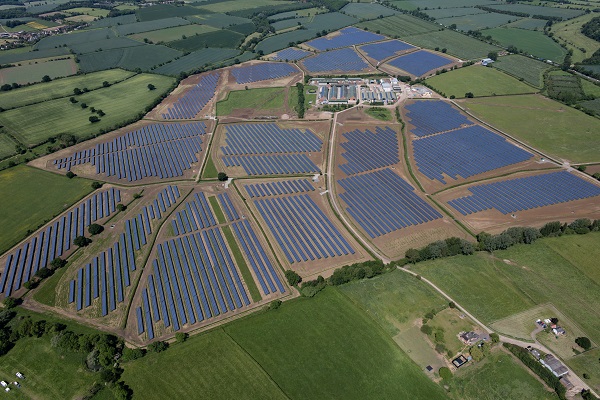
Cost is always an important lever, what about the cost structure of the way you develop projects, what role has Huawei played there?
This is where we go back to partnering, when we look at cost within Anesco we don’t look at the cost today or tomorrow, I could buy cheaper inverters currently than I get from Huawei, but what we look at is the whole-lifetime cost. When I look at the cost of a product, it’s the whole-of-life that I look towards. When I see some of the products and the guarantees that I can get, I’ve had more downtime with other inverters than I’ve had with Huawei.
Anesco does have some O&M contracts, sometimes for parks that Anesco hasn’t developed itself. How do you go about developing an O&M regime?
Our maintenance is proactive, we’d rather go out and maintain it than have it break down. So we have a tight rule on that. What we can say from the 21,000 assets that we manage, which is just shy of 700 MW, of the string inverters that we look after, we have the least number of failures with Huawei.
And how does it compare with central, do some of those parks have central inverters?
We don’t have central inverters generally, it hasn’t really been a big thing in the U.K. We’ve probably had two central inverters, and that really led to us moving to string inverters, because if one goes down you really lose the whole of the solar park.
Monitoring is to spot faults is clearly important. What role does Huawei’s monitoring solution play in your decision making?
I take it you mean the Huawei Fusion system. We’re in close discussions at the moment because we’re moving to the Fusion system for those reasons, it allows us to optimize the performance much better. It gives us transparency and real time information.
How is your monitoring operating today, before Fusion is applied?
We have a system in place where we can compare to the Huawei Fusion system and see that it is much better. Fusion is more scaleable as well. So going into the future, the next five years the Fusion system will be better than our current one.
We’ve talked about ground mounted systems, but the commercial rooftop segment in the UK has long been said to have good potential, in particular with other parts of Anesco’s business, such as delivering energy efficiency measures to large corporate clients. What activity are you seeing there?
We see that as a growth market. It’s perhaps been ignored because of the rush of everybody wanting to build solar parks before the end of March [the final RO grace period]. So everybody’s been saying for the last five years, ‘we can build solar parks, and why should we go for the smaller rooftop one, when its easier to build on the ground.’ I see that as a huge opportunity. We are looking at asking Huawei for rooftop inverters. We are working with a very good rooftop inverter at the moment, but I’m sure that when Huawei come out with its rooftop inverter in the U.K. it will be just as good if not better.
Could you give a bit of background in volumes you’ve done with Huawei.
Perhaps 85% of our business is Huawei. Just to let know, how seriously we take partnering, two long term supply chain partners we’ve had to move away from, because they didn’t demonstrate the views we’ve just talked about.
Exacting standards
Global Compliance and Testing Center: Huawei’s research campus in Shanghai performs a myriad of tests and performance analyses on the company’s highly-regarded solar PV inverters, setting a high level of quality and world-class standards that have underpinned its impressive global growth in such a short space of time.
Chinese ICT giant Huawei is set to make a splash this spring when it announces its entry into the IEC-standardized inverter markets of Europe and Australia at Intersolar Europe in late May.
The launch will be the opening salvo in its three-stage push into the global market for residential PV inverters. The Shenzhen-based company — a leading international supplier of string inverters for utility-scale solar plants — will follow this announcement with the official unveiling into the North American residential inverter market at Solar Power International in September, followed by an announcement into the Japanese market, likely in early 2018. It sees Europe/Australia, North America and Japan as its three core target markets outside of China.

“All markets are very important,” says Steven Zhou, Huawei’s general manager of residential smart PV solutions. “We can’t say one is more important than the other. Each residential market is different in terms of technology requirements, power ratings and the different solutions.”
In Japan, for example, Huawei has long known that simply retooling its offering for the European market would not suffice, given the country’s distinctively different JET certification standard. However, it understands local electrical requirements from its experience selling mobile phones and telecommunications equipment in the country, and it has an established sales and service network on the ground. So while its Huawei FusionSolar inverter will remain the core of its planned offering in Japan, it will be tooled to Japanese standards in three configurations, including a battery interface and optional optimizers.
Backed by its cloud monitoring service, sensors, 4G communication technologies and chipsets supplied by its HiSilicon unit, Huawei is capable of halving O&M costs for PV systems, according to Zhou. He declined to comment on pricing for its residential string inverter packages, beyond saying that they “will not be the cheapest” on the market.
The push into the residential inverter space is also supported by Huawei’s massive investments in R&D, with $10.99 billion of spending in 2016 bringing cumulative investment to $45 billion over the past decade. R&D expenditure last year alone was equal to roughly 14.6% of the group’s annual revenue of $75.1 billion. Zhou says Huawei “continuously” works to fine-tune its technologies from the initial development stage.
Put to the test
The Global Compliance & Testing Center (GCTC) in Shanghai is one of 15 R&D centres that Huawei operates throughout the world, on top of a facility to test inverter topology and algorithms in Sweden, an inverter architecture and design hub in Germany, and a chipset R&D base in California. But the work done at the GCTC — tucked away in a series of basement labs below Huawei’s sprawling research campus in Shanghai’s Pudong district — is dizzying in its scope.
The GCTC — which employs more than 180 people — conducts accelerated-life tests on Huawei’s inverters, as well as tests for vibration, icing, heat dissipation, salt corrosion, low pressure in high-altitude environments and resilience to impact and temperatures ranging from -55C to 80C.

The facility also assesses the electromagnetic compatibility (EMC) of the company’s inverters, including their electromagnetic susceptibility and emissions. The tests are conducted in accordance with the ISO/IEC17025 standard on top-shelf equipment supplied by companies such as Yokogawa Electric and Rohde & Schwarz, the latter of which is “supposed to be like the Mercedes-Benz of testing equipment,” according to Hariram Subramanian, Huawei’s CTO for PV inverter solution sales and marketing in Europe.
The GCTC includes absorbing chambers, which use bizarre-looking triangular foam protrusions on the walls to trap sound and eliminate echoes. The tests are key to ensuring that Huawei’s FusionSolar solutions do not emit noise in residential installations.
“The sound is trapped… what they get is only what is coming out of something,” says Xavier Daval, CEO of kiloWattsol, a Lyon-based PV yield-assessment firm that provides consulting services to Huawei. “So you have a pure analysis of the source — not the ambient result.”
The Shanghai research campus that GCTC is part of tests all of Huawei’s products, from solar inverters to mobile phones. The company’s commitment to R&D has underpinned its rapid advances in the PV inverter market, and extensive testing of its products continues to create the confidence it needs to expand into new global markets, according to Daval.
“A company like Huawei cannot guess if something is going to be good. They have to check it,” he explains, adding that the group’s background in communications technology made it a “no brainer” for it to expand into the PV inverter market.
“You can’t succeed in the time range that Huawei did without the back-up of a real global structure, logistics, factories and so on. It cannot be just the product — it’s the product plus supply chain. Huawei is a very special company — they are Chinese but they are very much an international brand.”
This page was last updated on June 20, 2022.

